
Admin
-
Posts
7,477 -
Joined
-
Last visited
Content Type
Profiles
Forums
Events
Store
Gallery
Community Map
Posts posted by Admin
-
-
-
-
Hello Welsh rider,
Welcome to The Motorbike Forum. Please feel free to browse around and get to know the others. If you have any questions please don't hesitate to ask.
Why not tell us a bit about yourself too.
-
Hello Rider UK,
Welcome to The Motorbike Forum. Please feel free to browse around and get to know the others. If you have any questions please don't hesitate to ask.
Why not tell us a bit about yourself too.
-
Hello aadesh,
Welcome to The Motorbike Forum. Please feel free to browse around and get to know the others. If you have any questions please don't hesitate to ask.
Why not tell us a bit about yourself too.
-
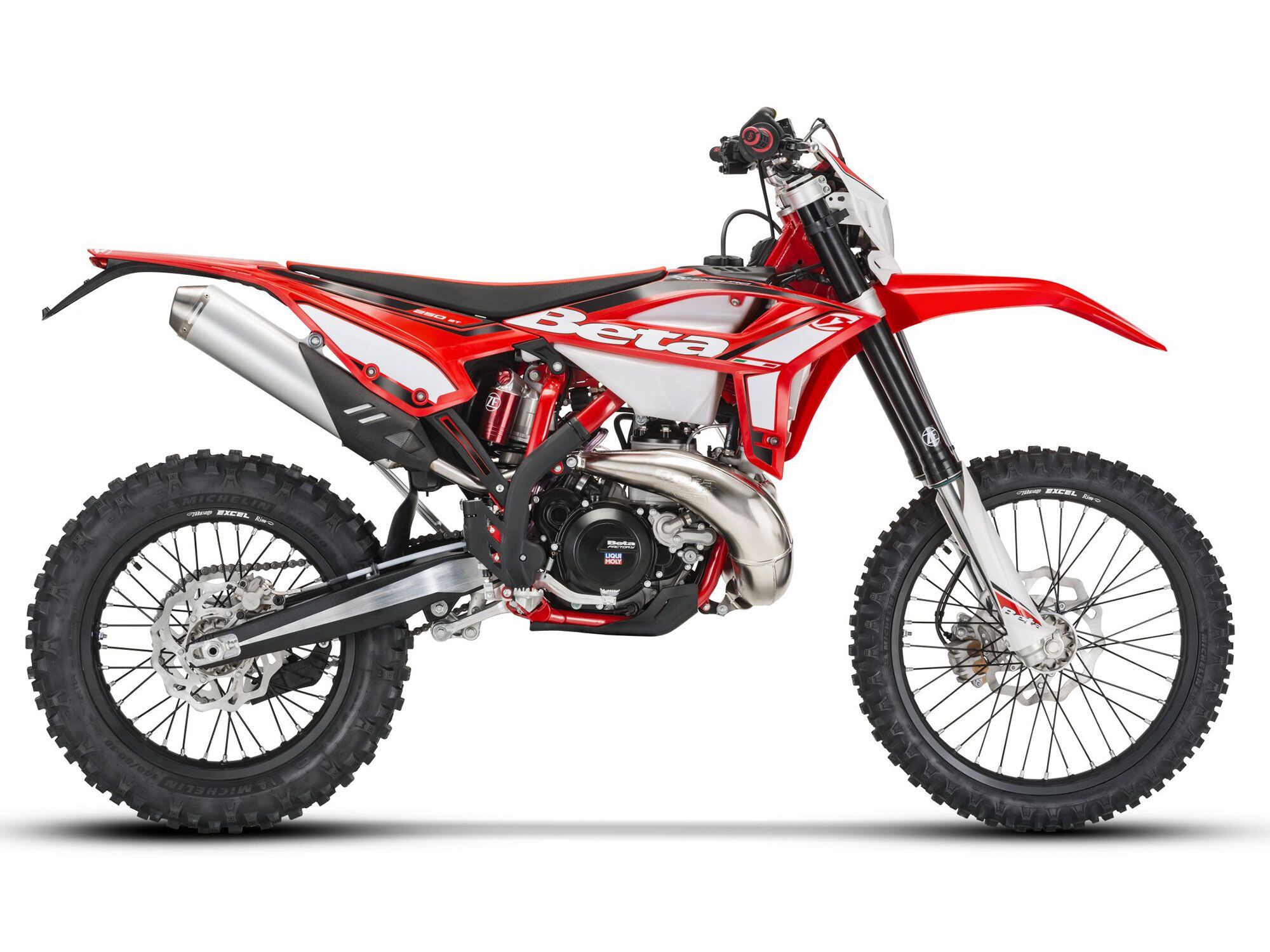
2021 Beta 250 RR (Beta/)Ups
- Precise steering helps it dominate the single-track<br/>
- Premixed fuel is not required since it is oil-injected<br/>
- Somewhat surprising power<br/>
- Minimal engine vibration thanks to its solid counterbalancer<br/>
- Smooth hydraulic clutch
Downs
- 2.6-gallon fuel tank could be a little larger capacity for longer rides<br/>
- Slightly uncomfortable at the handlebar
Verdict
Positive aspects of the Beta’s ride quality, engine, and smooth clutch give this bike a high-scoring grade of an A-, according to our test rider Allan Brown.
Overview
The Beta 250 RR is the Italian manufacturer’s 249cc two-stroke off-road dirt bike. It is designed to be more than just a playbike for the casual off-road rider or racer, from technical enduro terrain to single-track or casual fire roads and any fun riding in between.
Updates for 2021
As we covered in our review, updates include a stronger rear subframe, changes to the shim stacks in the fork and shock, a new seat foam and seat base, an improved air filter housing, new mounting of the side panel, and a red color scheme.
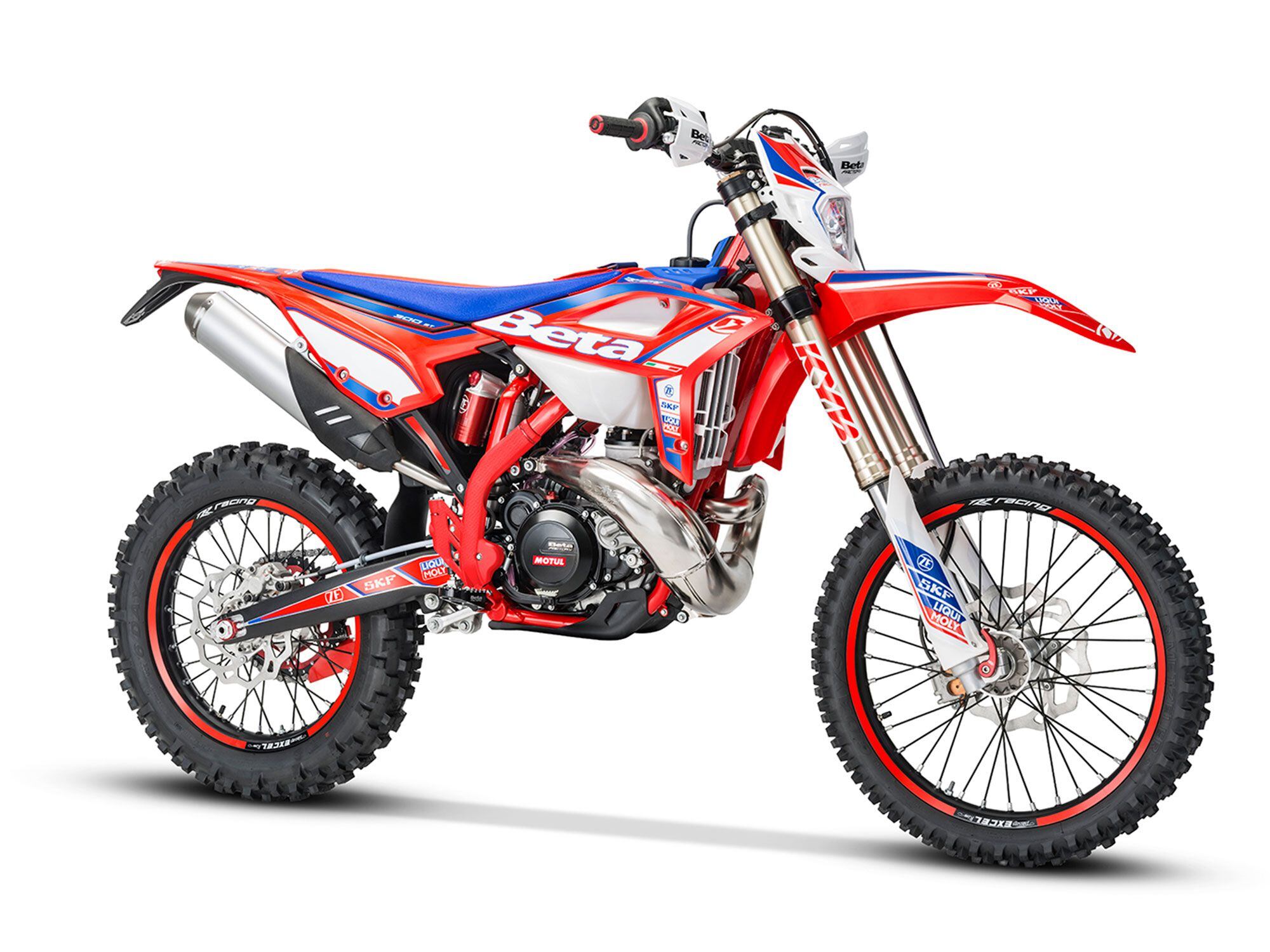
2021 Beta 250 RR Race Edition (Beta/)Pricing and Variants
The base-model Beta 250 RR has an MSRP of $8,799, but it is also offered in a Race Edition that comes in at $9,399. A couple of the main differences between the two is the Race Edition swaps the base model’s Sachs front suspension with a KYB AOS (Air-Oil Separate) closed-cartridge fork, and Michelin Enduro competition tires for Metzeler 6 Days off-road tires. The Race Edition also features hand guards, racing graphics, and seat cover.
Powertrain: Engine, Transmission, and Performance
When tested on our in-house dyno, the 250′s numbers were not too far off from the 300 RR, the brand’s highest-displacement off-road model, that we dynoed last year. The 2021 Beta 250 RR’s peak figures were 38.9 hp at 8,100 rpm and 27.3 pound-feet of torque at 6,600 rpm.
When we rode the 250 we were surprised that its power did not fall too far (0.4 less peak horsepower and 1.1 pound-feet less peak torque) behind its bigger sibling. We did notice that, “While there is a small reduction in midrange torque compared to its larger-displacement sibling, the 250 RR engine runs very well and is lighter and more free revving.” The engine’s counterbalancer keeps engine vibration to a minimum.
Its six-speed transmission has a super-low first gear and decent spacing up to sixth, and the Brembo clutch works smoothly, we reported.
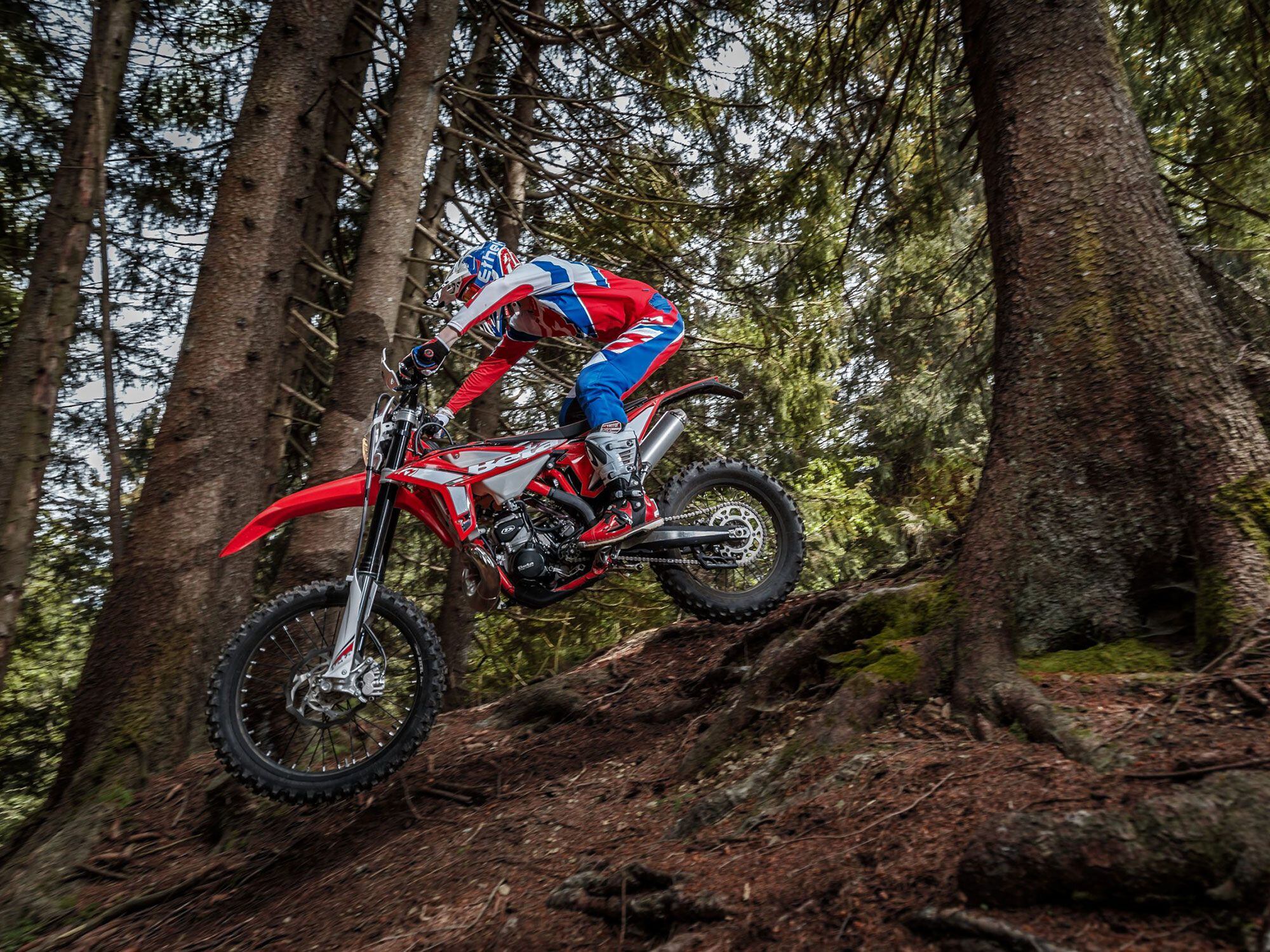
2021 Beta 250 RR (Beta/)Handling
A slightly rigid chassis and point-and-shoot-like steering from a communicative front end combine to make the Beta a single-track dominator. DOT-approved Michelin enduro tires provide impressive lean-angle traction and confidence on harder-packed surfaces as well.
The fully adjustable Sachs suspension of the base model we tested allowed for easy tuning, and we did notice the “rear of the bike tracks well and the Sachs shock has a little more holdup than the fork.”
Brakes
Braking is done with a Nissin two-piston caliper and 260mm disc combo up front and a Nissin single-piston caliper and 240mm disc out back.
Fuel Economy and Real-world MPG
Although fuel economy numbers are currently unavailable, we did note that the fuel mileage is not the best if the bike is ridden hard.
Ergonomics: Comfort and Utility
The Beta has a narrow chassis and an open, flat cockpit that allow for easy body position adjustments; however, we would like to see better comfort in the handlebar.
Electronics
The Beta is equipped with an electric starter, but a kickstarter is sold as a separate option for approximately $400. An ignition map button is located above the fuel tank and is used to toggle between two map settings. A full light kit with pre-wired turn signal connections is also included. A compact dash is mounted in front of the bar pad to provide the rider with handy information.
Warranty and Maintenance Coverage
Both the base and Race Editions of the 250 RR include a six-month limited warranty.
Quality
The Beta 250 RR receives high scores from our Cycle World test rider for its versatile rideability and surprising power. The updated suspension really refines the package as well. Just a couple of minor infractions with the handlebar and fuel tank size hold it back from receiving an A+.
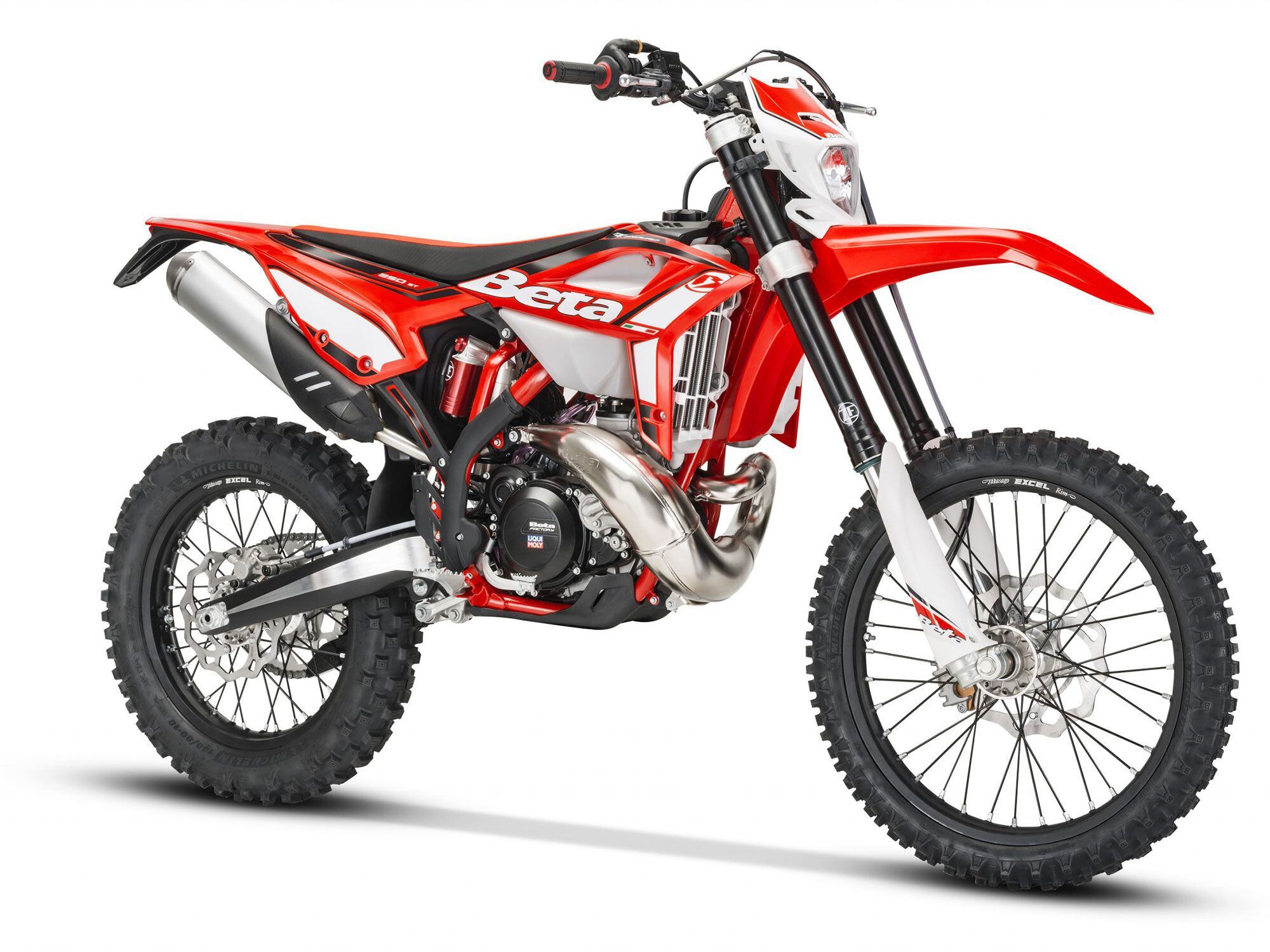
2021 Beta 250 RR (Beta/)2021 Beta 250 RR Claimed Specifications
MSRP: $8,799 Engine: 249cc, liquid-cooled, single-cylinder two-stroke Bore x Stroke: 66.4 x 72.0mm Transmission/Final Drive: 6-speed/chain Fuel Delivery: Keihin PXK 36mm carburetor Clutch: Wet, multiple disc, hydraulically operated Engine Management/Ignition: AC-CDI Kokusan w/ dual map switch Frame: Steel double cradle Front Suspension: 48mm Sachs inverted fork, fully adjustable; 11.6 in. travel Rear Suspension: Sachs shock, fully adjustable; 11.4 in. travel Front Brake: 2-piston caliper, Nissin 260mm disc Rear Brake: 1-piston caliper, Nissin 240mm disc Wheels, Front/Rear: Spoked wheels Tires, Front/Rear: Enduro competition; 21 in. / 18 in. Rake/Trail: N/A Wheelbase: 58.3 in. Ground Clearance: 12.6 in. Seat Height: 36.6 in. Fuel Capacity: 2.6 gal. Wet Weight: 228 lb. (w/o fuel) Contact: betausa.com Cycle World Tested Specifications
Seat Height: 37.3 in. Wet Weight: 247 lb. Rear-wheel Horsepower: 38.9 hp @ 8,100 rpm Rear-Wheel Torque: 27.3 lb.-ft. @ 6,600 rpm -
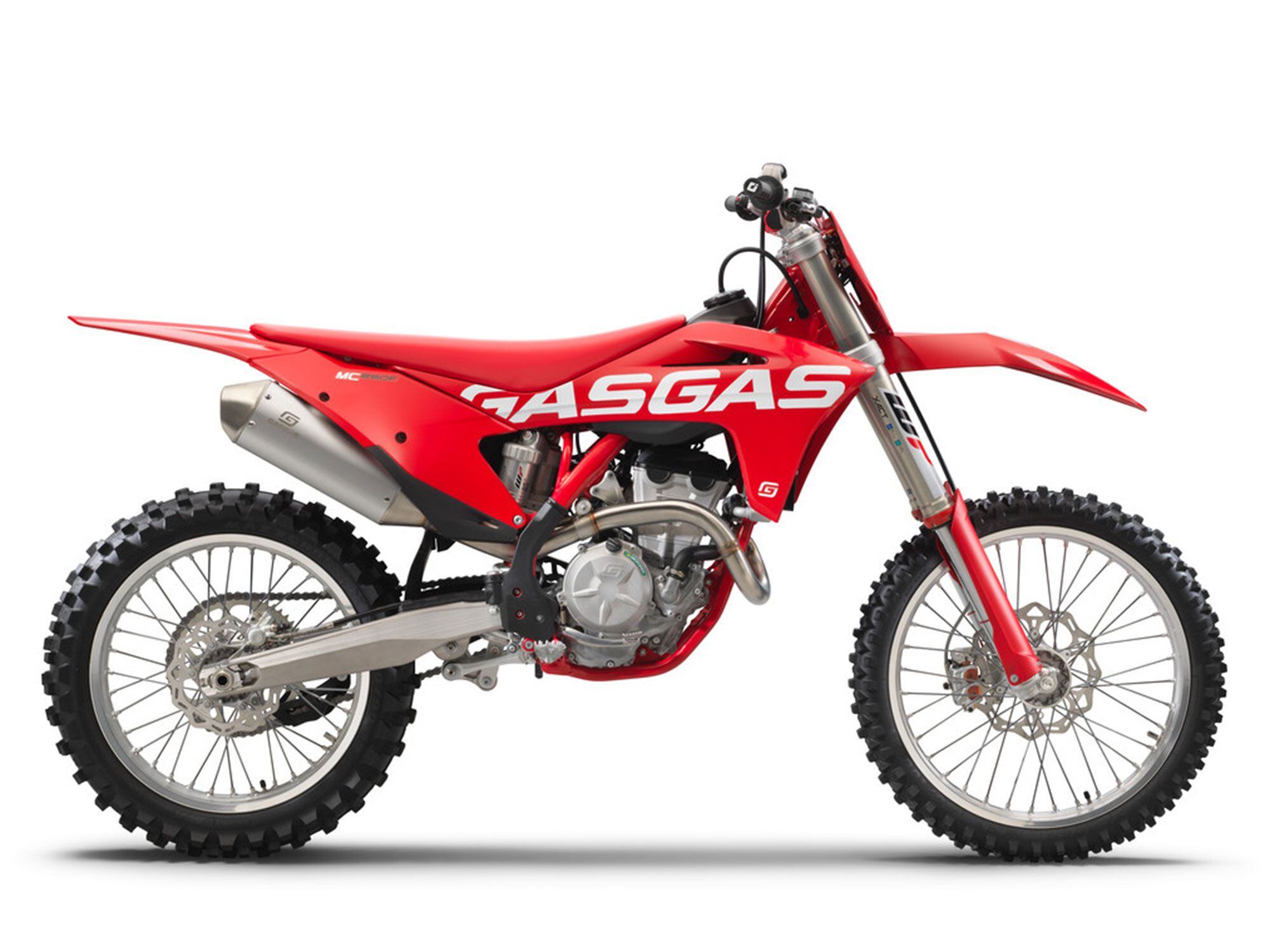
2021 GasGas MC 250F (GasGas/)Ups
- Another viable addition to the competitive 250 four-stroke market<br/>
- User-friendly engine<br/>
- Light-feeling chassis with its mixture of KTM/Husqvarna/GasGas components<br/>
- A slightly lower-than-average price tag in the class<br/>
- Very good bottoming resistance
Downs
- OK low-rpm recovery, which could be improved by installing the optional ventilated airbox cover that comes with the KTM 250 SX-F<br/>
- Brembo hydraulic clutch could use more feel at the lever
Verdict
Similar to KTM and Husqvarna, the GasGas MC 250F provides a premium package but a lower-than-average price.
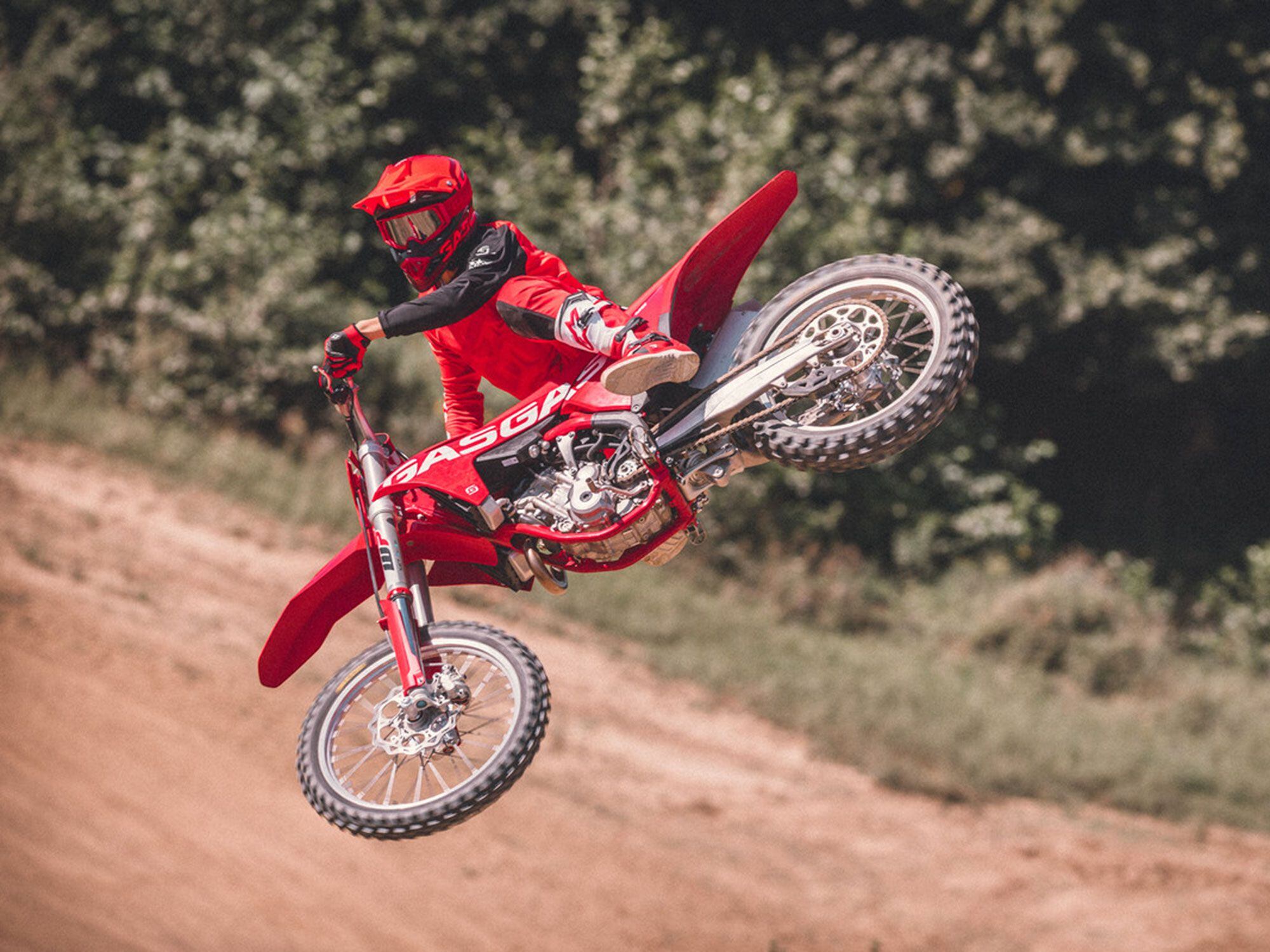
2021 GasGas MC 250F (GasGas/)Overview
The 2021 GasGas MC 250F tallies in as the third 250 motocrosser under the KTM/Husqvarna/GasGas umbrella and is the first-ever production 250 four-stroke MXer for GasGas. Although similar to the KTM 250 SX-F and Husqvarna FC 250, the MC 250F does have characteristics that set it apart: forged triple clamps, a header pipe free of a resonance chamber, and Maxxis MX-ST tires are the main component differences of the red machine over its Austrian counterparts. Also, the MC 250F does not come with the map/traction control switch that is a standard feature on the 250 SX-F and FC 250.
Updates for 2021
This is a new 250 motocrosser for GasGas, and as such, there aren’t “upgrades” per se. The whole machine is new.
Pricing and Variants
With a price tag of $8,499, the GasGas MC 250F is $800 and $900 cheaper than the KTM and Husqvarna, respectively, and is priced only $200 more than Yamaha’s YZ250F and Kawasaki’s KX250, $500 more than Honda’s CRF250R, and $600 more than Suzuki’s RM-Z250.
Powertrain: Engine, Transmission, and Performance
The 250cc, DOHC, liquid-cooled engine delivers smooth, steadily building power, but does not have as much over-rev as KTM’s 250 SX-F, we reported in our first ride review. “The engine has a nice light feeling, the throttle response is good, and the mapping seems to run clean.”
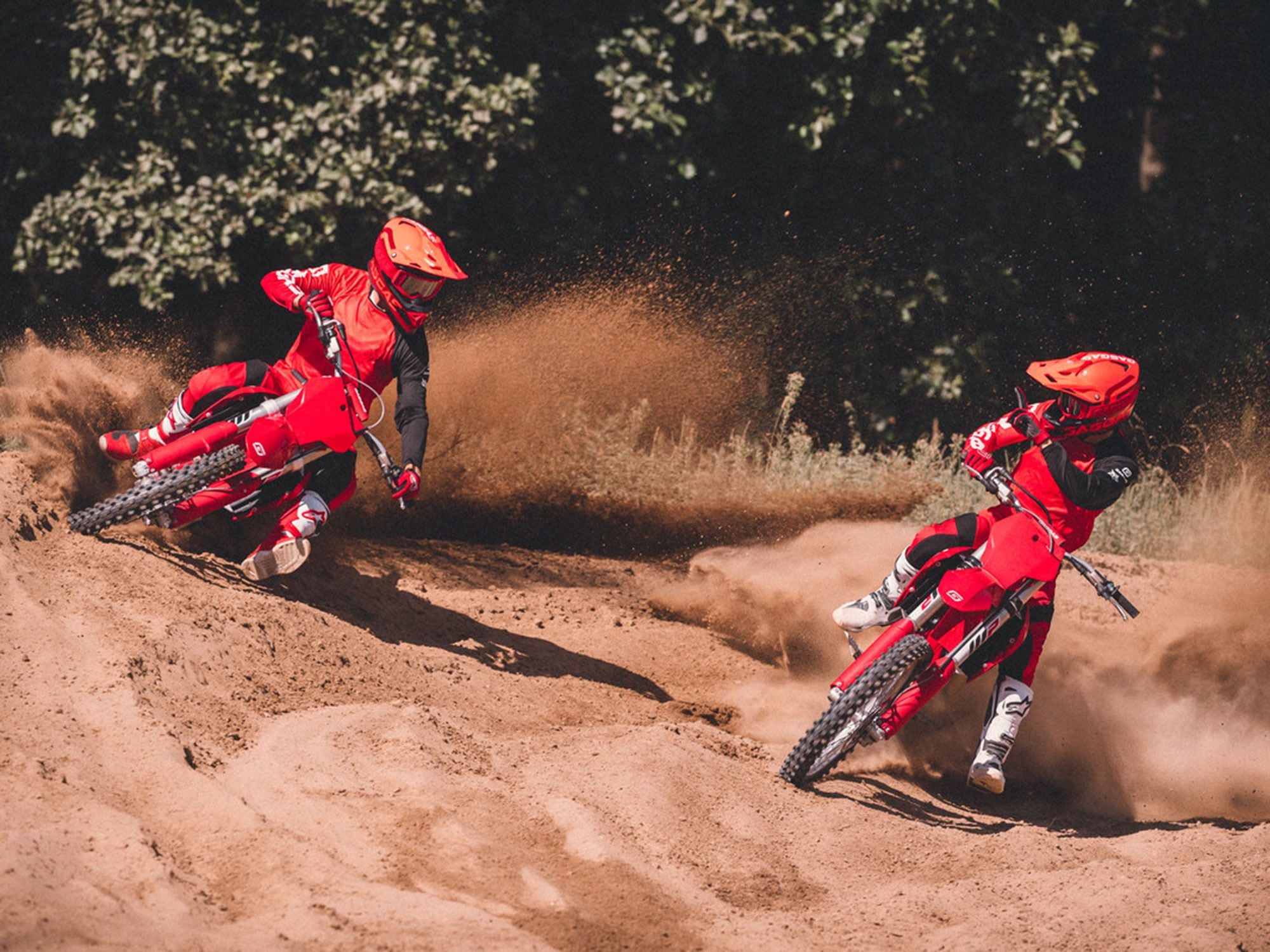
2021 GasGas MC 250F (GasGas/)Handling
Combining chassis elements like the frame and subframe from KTM, swingarm from Husqvarna, and GasGas-specific WP suspension settings, the result is a very light and nimble chassis. Stiffening the suspension could provide a better feel in the initial part of the stroke in our test rider’s opinion, but bottoming resistance is very good right out of the box.
Brakes
Up-spec Brembo calipers assist in stopping the MC 250F. The front disc is 260mm in diameter and the rear disc is 220mm.
Fuel Economy and Real-world MPG
Average mpg is currently unavailable for this model, however, the 1.8-gallon fuel tank does place it in the larger-capacity realm for the class. KTM and Husqvarna, as one would expect, have the same tank size, but Yamaha, Honda, and Kawasaki offer 1.6-gallon capacities with the Suzuki at 1.7 gallons.
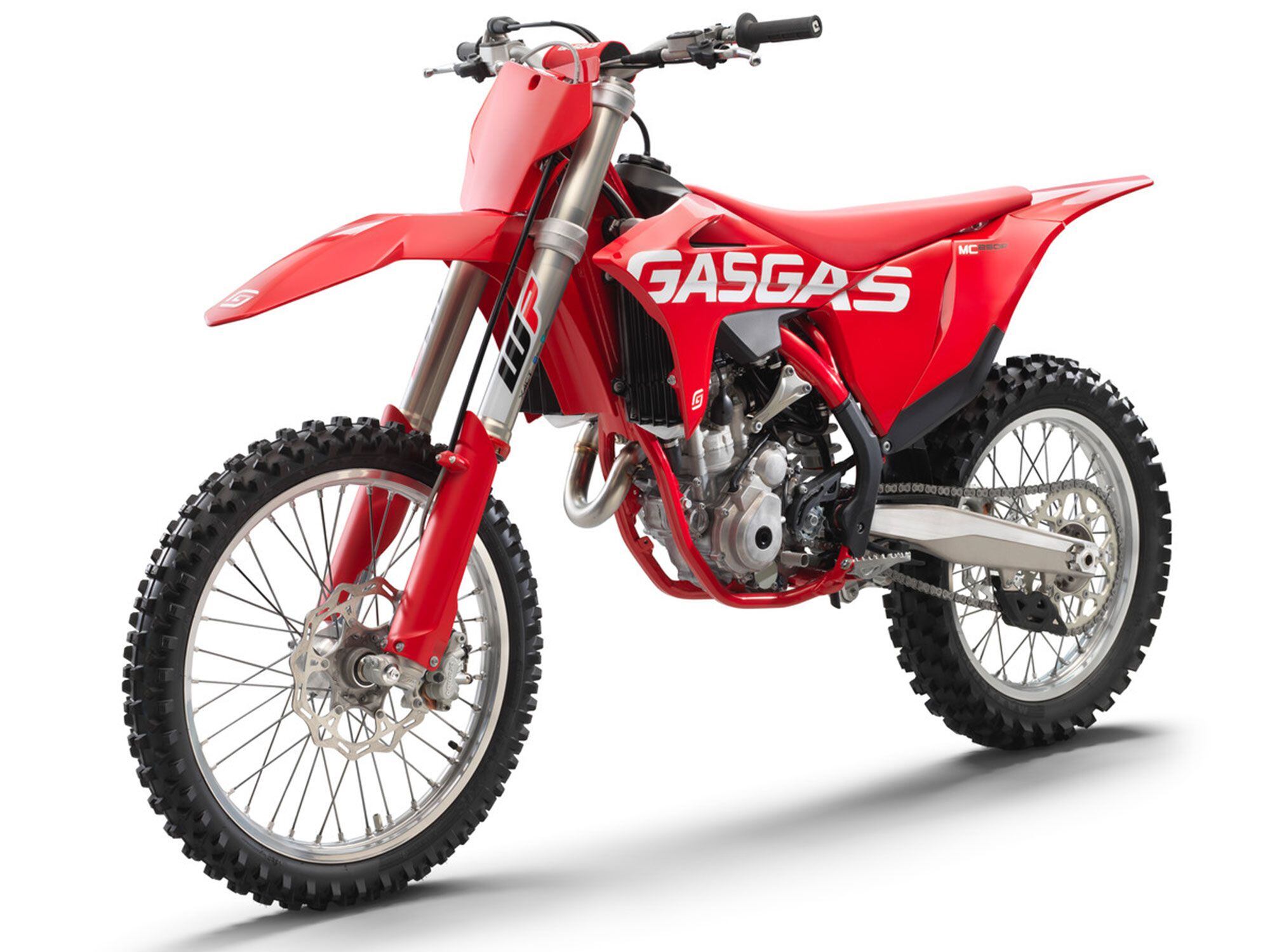
2021 GasGas MC 250F (GasGas/)Ergonomics: Comfort and Utility
Again, GasGas pulls features from KTM, more specifically with the same brakes, footpegs, levers, and controls as well as a similarly shaped Neken handlebar.
Electronics
The MC 250F’s electronics include a Keihin EMS and an electric starter that is powered by a lithium-ion battery. GasGas does not offer a handlebar-mounted map/traction control switch in stock trim on its 250 four-stroke motocrosser, but the component can be purchased from GasGas Technical Accessories for approximately $169.
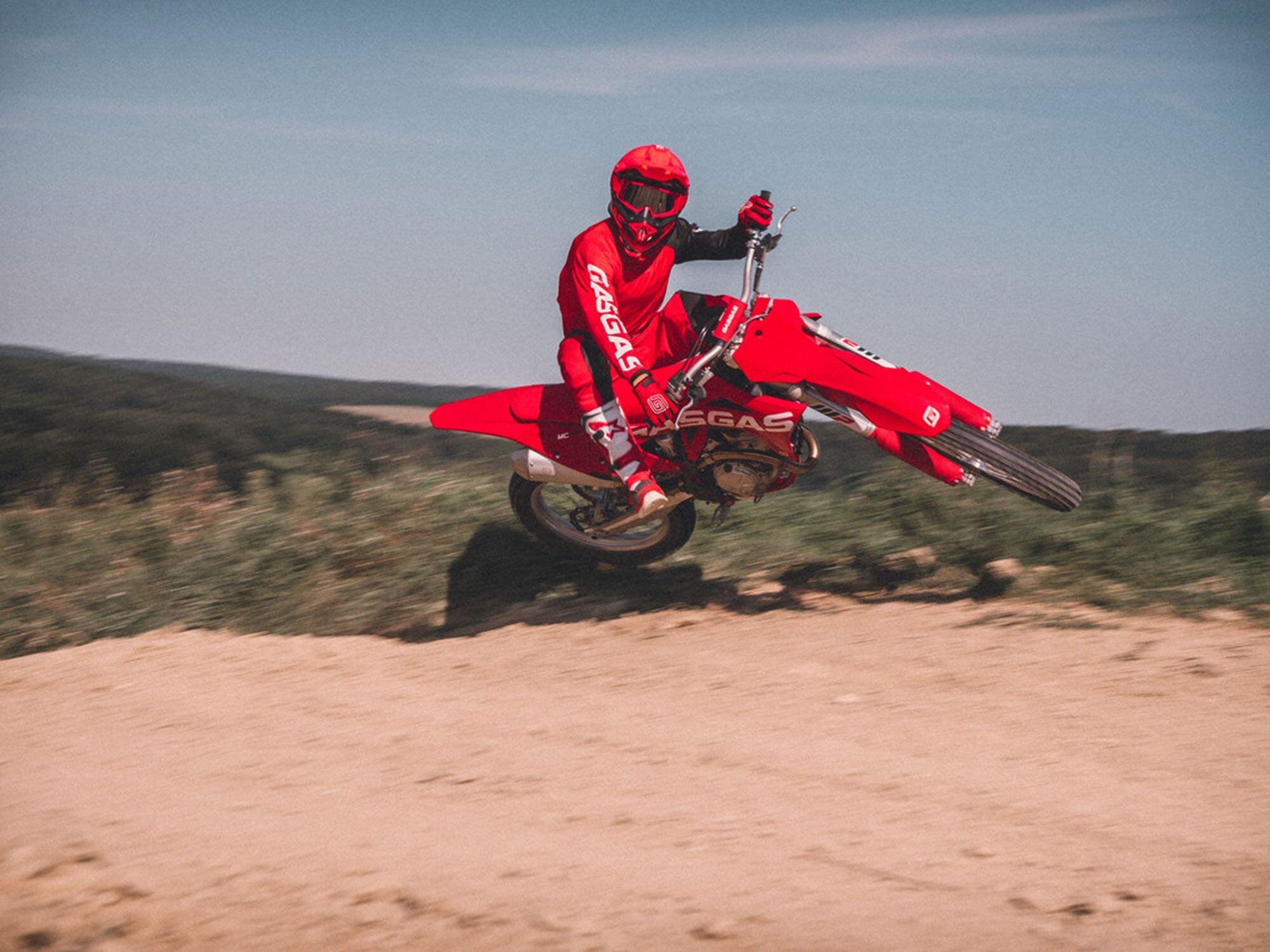
2021 GasGas MC 250F (GasGas/)Warranty and Maintenance Coverage
Warranty coverage is 30 days from date of purchase.
Quality
The GasGas is a premium motorcycle with KTM and Husqvarna features, but comes at a lower price, leaving room in the budget for accessories such as the map switch if one desires.
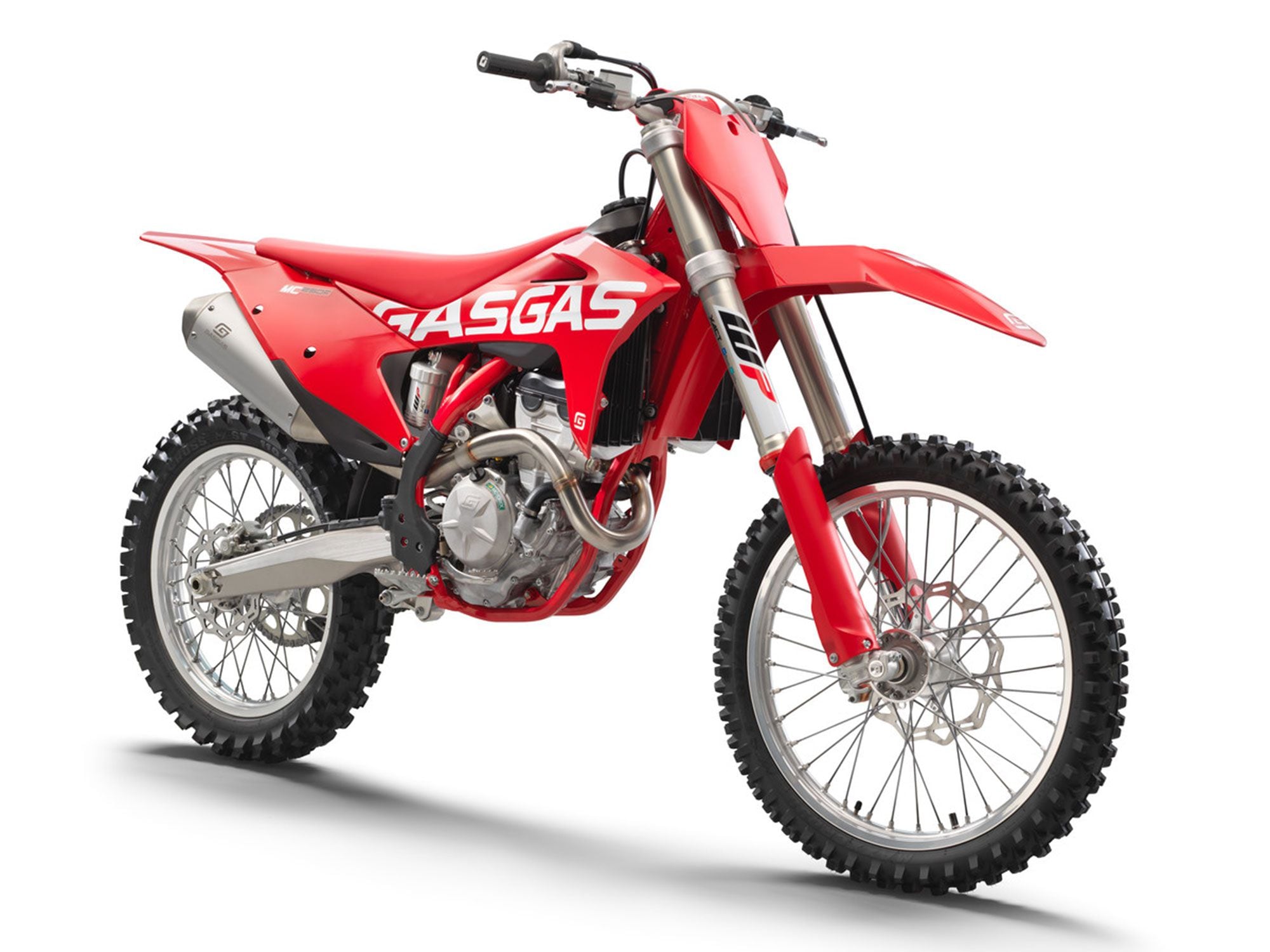
2021 GasGas MC 250F (GasGas/)2021 GasGas MC 250F Claimed Specifications
MSRP: $8,499 Engine: 250cc, DOHC, liquid-cooled, single-cylinder four-stroke Bore x Stroke: 78.0 x 52.3mm Transmission/Final Drive: 5-speed/chain Fuel Delivery: Electronic fuel injection w/ 44mm throttle body Clutch: Wet, multiple disc Engine Management/Ignition: Keihin EMS Frame: Steel central double cradle Front Suspension: 48mm WP Xact fork, air pressure, compression damping, and rebound damping adjustable; 12.2 in. travel Rear Suspension: WP Xact shock, fully adjustable; 11.8 in. travel Front Brake: Brembo 2-piston caliper, 260mm disc Rear Brake: Brembo 1-piston caliper, 220mm disc Wheels, Front/Rear: Spoked wheels Tires, Front/Rear: N/A Rake/Trail: 26.1°/N/A Wheelbase: 58.5 in. Ground Clearance: 14.6 in. Seat Height: 37.4 in. Fuel Capacity: 1.8 gal. Wet Weight: 218 lb. (w/ all fluids except fuel) Contact: gasgas.com -

Kawasaki’s updated H2 SX sport-tourer looks to be packing a radar sensor up front. (S. Baldauf/SB-Medien/)There are already three motorcycles on the market in 2021 that offer radar-assisted adaptive cruise control—Ducati’s Multistrada V4 S, BMW’s R 1250 RT and KTM’s new 2021 1290 Super Adventure S. Kawasaki is clearly preparing to be the next to join the fray with an up-spec’d version of its supercharged H2 SX.
It was back at the 2019 EICMA show that Kawasaki first announced it had inked a deal to buy the Bosch ADAS (Advanced Driver Assistance System) technology, including its adaptive cruise control, forward collision warning system, and rear blind spot monitoring setups, but the company was clear in its statement that “no date has been set for the introduction of the ADAS system on Kawasaki machines or, as yet, which machines it will be featured on.”
Now we can answer at least one of those questions, as these spy shots show an updated H2 SX complete with a modified headlight and revised front styling to accommodate the Bosch radar sensor.

The headlight has been modified around the new radar sensor, and the fairing has also been changed around the air intakes on the front and side. (S. Baldauf/SB-Medien/)The radar system itself is familiar; it’s the same setup used by Ducati, BMW, and KTM in their 2021 models. That system allows for adaptive cruise control, so the bike can be set to maintain a constant following distance behind the vehicle in front of it. Depending on programming, the unit can also be used to allow an amount of automated braking or a collision warning to alert the rider if the vehicle ahead slows suddenly.
RELATED: Kawasaki To Employ Radar-Assisted Safety Systems
In 2019, Geoff Liersch, president of Bosch’s Two-Wheeler & Powersports arm, said: “Bosch continues to make riding safer, more efficient, and fun around the world, and we are honored to supply Kawasaki as the first Japanese manufacturer with the complete advanced rider assistance systems.”
Yuji Horiuchi, president of Kawasaki’s Motorcycle & Engine division, added: “We are glad to announce that our motorcycle will be equipped with Bosch’s advanced rider assistance systems, which gives more safety and comfort to riders.”

The deal to get Bosch radar tech was first announced by Kawasaki back in 2019. As with the BMW and KTM systems, it allows for adaptive cruise control. (Kawasaki/)At the moment all three European manufacturers look to have opted to leave the front radar sensor unit exposed, with a rectangle of black plastic clearly visible on the nose of their bikes. Kawasaki, however, appears to have adopted a more sculpted cover for the sensor, which sits below a new, much smaller LED headlight.
RELATED: Ducati Multistrada To Get Radar Safety System
The limitations of radar sensors mean that while they can “see” through plastic bodywork, their cover panels have to be smooth and uninterrupted so they don’t interfere with radio waves bouncing back to the sensor. Carmakers using the same sensors usually employ a section of smooth grille, and Kawasaki’s solution appears to be a similarly blank panel sitting below the new light. Chances are that the radar will be used only on the highest-spec H2 SX SE+ model, so on lower versions of the bike, the same area might well be used for a headlight, allowing all versions to use the same body panels.
The new headlight sits higher than the old version, with the bodywork reshaped to suit, but overall the styling of the H2 SX hasn’t been significantly altered, retaining the existing side panels with their oversize cornering lamp units and exaggerated strakes over the cooling vents.

The H2’s new TFT dashboard looks similar to the units on those other brands’ Bosch-radar-equipped bikes. (S. Baldauf/SB-Medien/)On board, it’s possible to see that the radar-equipped bike has a new TFT dash that looks suspiciously like the unit used on some 2021 BMW models. That wouldn’t be a surprise, as it’s also a Bosch-made component that ties in with the rest of the ADAS kit.
One thing we don’t see is a conspicuous rear-facing radar sensor. At the moment, only Ducati has chosen to adopt the rear radar on its Multistrada V4 S. KTM demonstrated prototypes with the system, which provides blind spot warnings via lights set into the rearview mirrors when vehicles approach from behind, but hasn’t chosen to implement it in the first production model to use the Bosch safety kit. The Kawasaki prototype does appear to have a rear-facing camera fitted rather than a radar sensor, but the lens that’s visible just below the luggage case (which is packed with sensors and computers for testing purposes) looks like it’s part of the test kit rather than a production element. The camera could be recording what a (perhaps hidden) rear-facing radar would see. Or could be a rough test unit for integrated camera tech.

There’s no rear radar sensor on the Kawasaki as yet, just a camera that doesn’t appear to be a production element. (S. Baldauf/SB-Medien/)The H2 SX prototype answers one of the questions that Kawasaki wouldn’t comment on in 2019—which bike will be fitted with the radar. Patents filed by the firm have also shown a radar-equipped Versys 1000, so the supercharged bike is likely to be just the first of several Kawasakis to get the kit. The second unanswered question—when will the system be available?—is still hanging, but the existence of the prototype seen here suggests that 2022 is likely to be the answer.
-
Hello MISTX1X,
Welcome to The Motorbike Forum. Please feel free to browse around and get to know the others. If you have any questions please don't hesitate to ask.
Why not tell us a bit about yourself too.
-
-
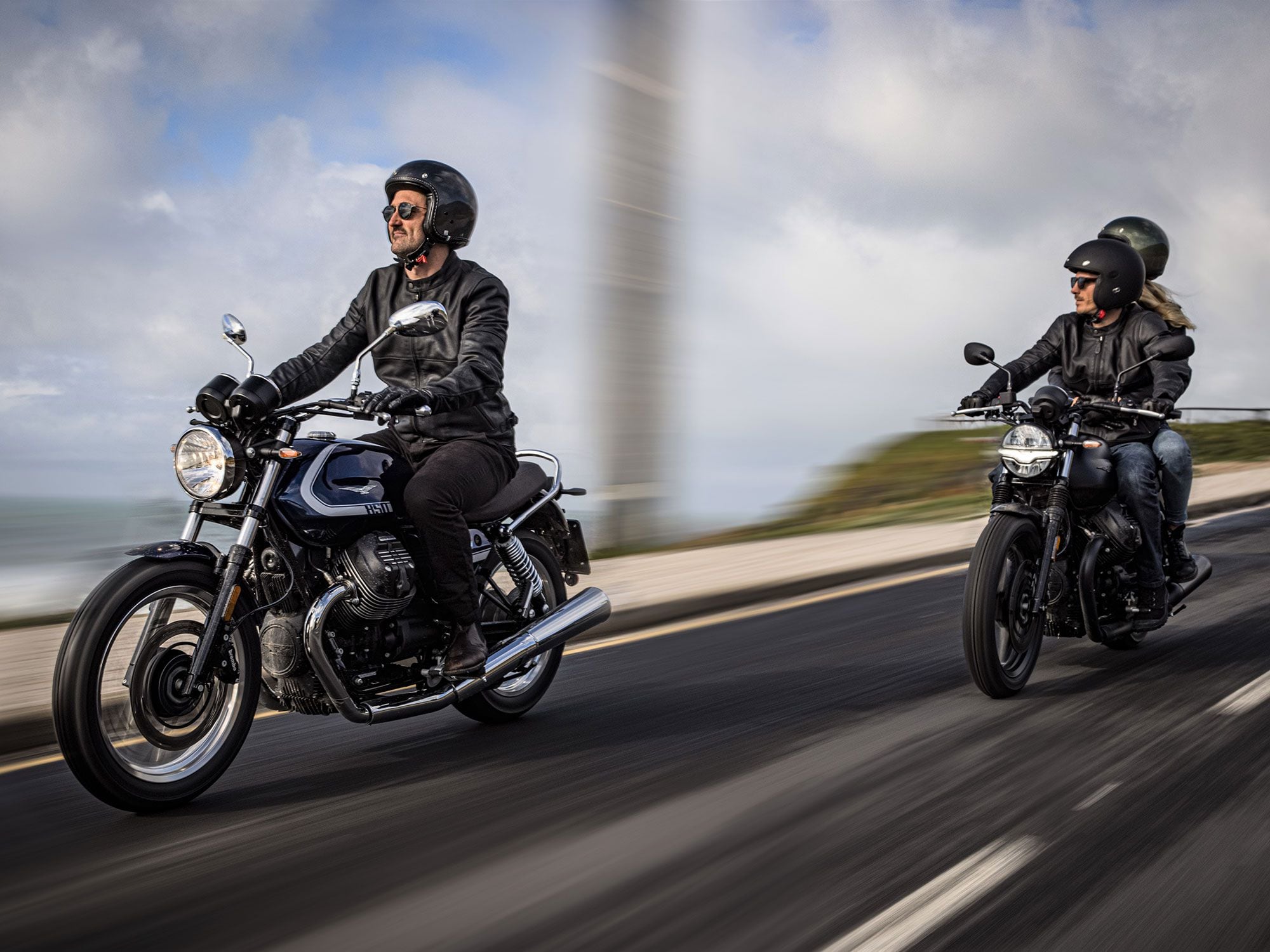
Moto Guzzi’s two revamped 2021 V7 models will hit US and Canada markets by springtime, with a slight price boost. (Moto Guzzi/)When we got word back in December that Moto Guzzi’s popular middleweight V7 was receiving a major upgrade in the form of a new 853cc motor for 2021, we applauded the power boost, but other than max output claims and brief mentions of chassis, suspension, and cosmetic “enhancements,” we were still left in the dark as far as pricing or availability went. That, plus no spec sheet was forthcoming. Well, all that seems to have now worked itself out, with Guzzi finally announcing that both the new V7 Special and V7 Stone models (and the V7 Stone 100th Anniversary, if you want to count that) will reach North American shores by early spring of 2021, and with a price tag just slightly higher than their predecessors.
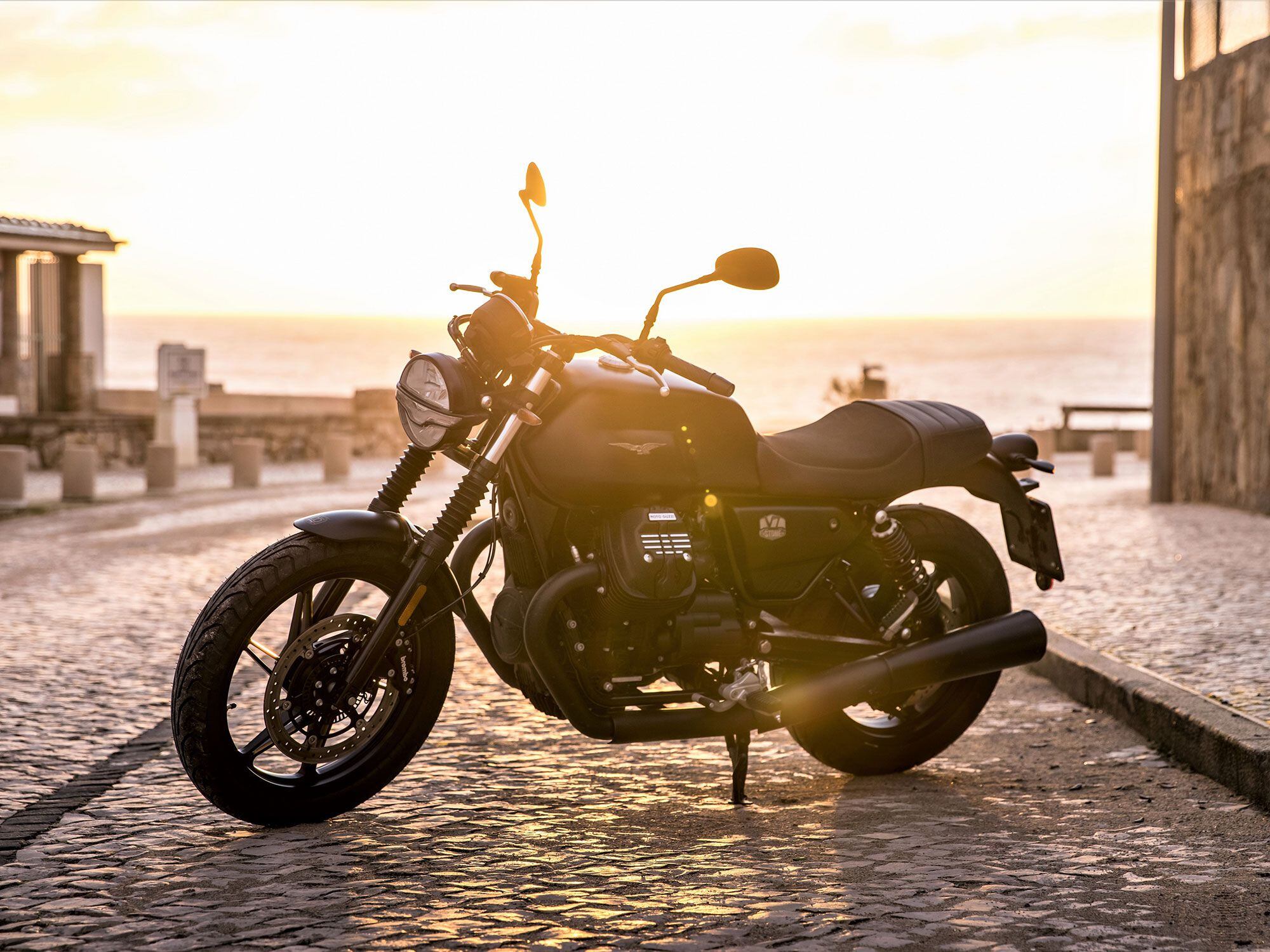
The 2021 V7 Stone will be priced at $8,990 and is set to arrive in dealers by late March. (Moto Guzzi/)As we already learned, the aforementioned “new engine” is closely related to the mill in the V85 TT adventure bike, albeit somewhat detuned to give more credence to the V7 status as Guzzi’s entry-level machine. Still it’s probably the highest-performance engine mounted in this model’s history, with a claimed 25 percent more power than its V7 III predecessor, or 65 hp at 6,800 rpm (up from the previous 52 hp at 6,200 rpm). Maximum torque has also increased, going to 53.8 pound-feet at 5,000 rpm, and Guzzi claims the new V7s accelerate faster, yet are more fuel efficient too.
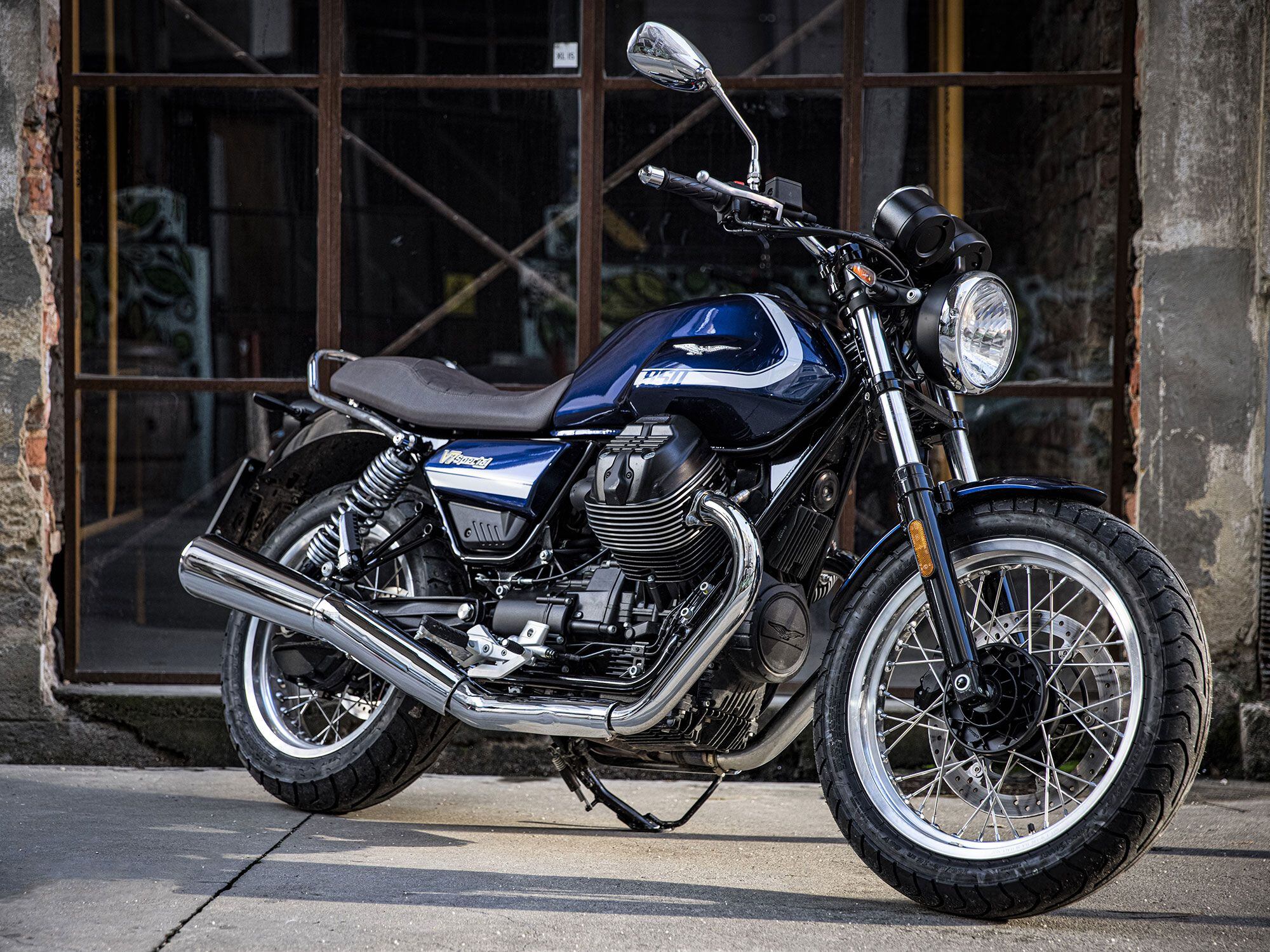
The V7 Special will cost you $9,490 and it’ll also be coming to the US in early spring. (Moto Guzzi/)Skimming over the other changes, we also see a different arrangement for the chunky exhaust pipes, and a larger cardan final drive and swingarm with a new bevel gear, while a wider rear wheel is suspended by a robust pair of longer-stroke exposed Kayaba dual shocks mounted at a more forward lean. Guzzi also mentioned reinforcements to the frame and the headstock area, the fitment of a larger shaft final drive, and new aluminum wheels on the Stone, which wear a wider 150-section rear tire (though it’s still 17 inches). The gearbox was also revamped to reduce noise and gear play.
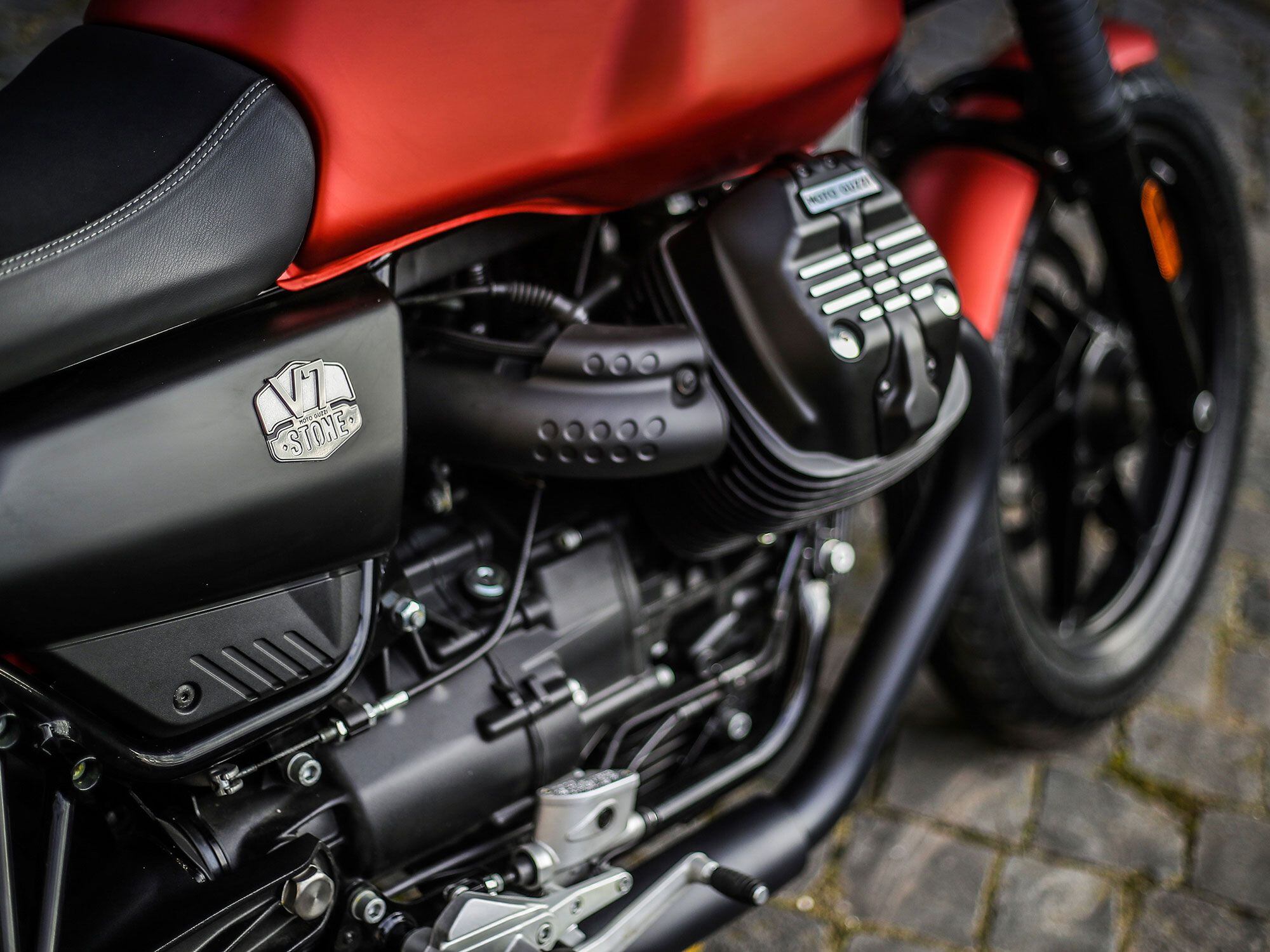
The new 853cc V-twin engine on the 2021 V7s is based on the higher-powered mill found in Guzzi’s V85 TT model. (Moto Guzzi /)There’s also a thicker, new saddle that, together with a new vibration-damping footpeg arrangement, is meant to improve your comfort level in the saddle, and the usual raft of cosmetic “refinements” to keep your visual interest. That includes stylish new side panels and a shorter rear fender, and wide new aluminum wheels on the Stone (to also improve stability and grip). Standard on both bikes are the ABS system and an adjustable MGTC (Moto Guzzi Traction Control) system that can also be disabled, and is adjustable to two sensitivity levels.
RELATED: 2017 Moto Guzzi V7 III Makes US Debut
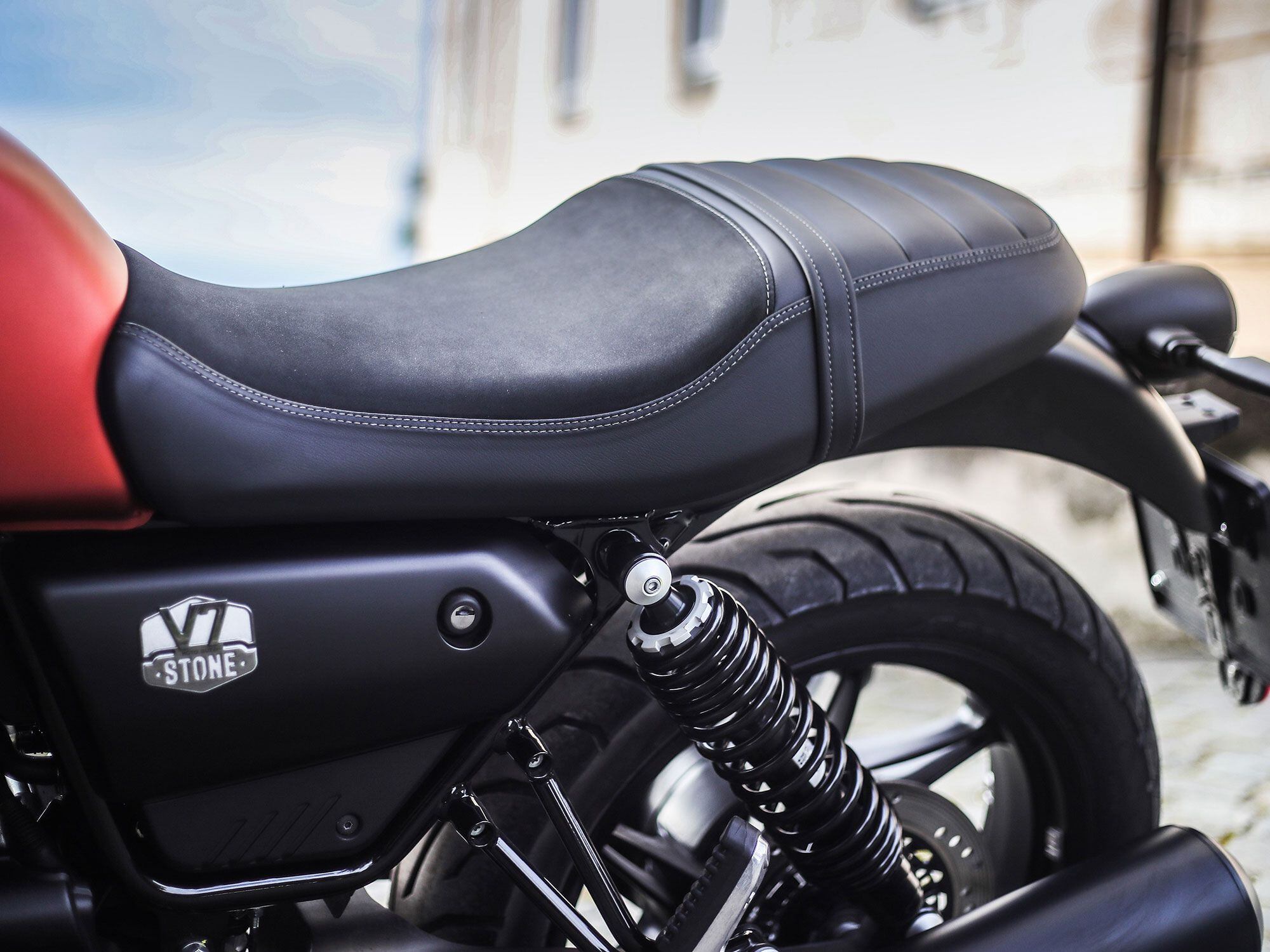
Both 2021 V7s also mount new longer-stroke Kayaba shocks at a different angle for better bump absorption. (Moto Guzzi/)After that, it comes down to your style choice, with the base Stone wearing six-spoke cast wheels and a single gauge with digital display, along with full LED lighting. If you’re leaning more retro, go with the V7 Special, with its silver spoke wheels and dual analog dials, all capped with a brown saddle.
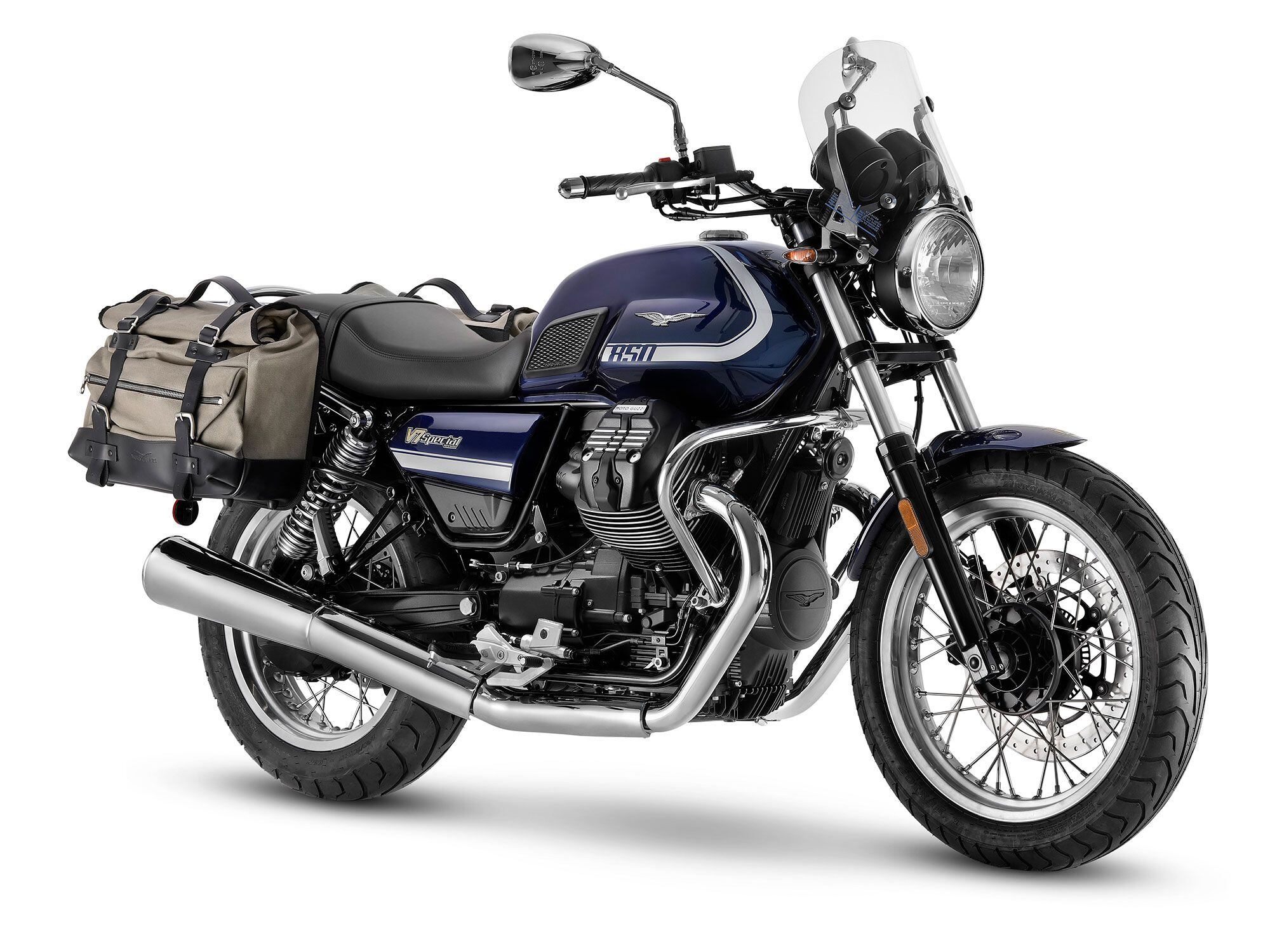
New accessories? Guzzi rolled out the supporting goods. Choose side panniers in hand-crafted leather, elegant canvas, or tough technical fabric. (Moto Guzzi/)The V7 Stone will be priced at $8,990 when it arrives this March to North American dealers, or $500 more than its smaller 2020 V7 III forebear. The V7 Stone 100th Anniversary will retail for $9,190, while the V7 Special has an MSRP of $9,490. The latter two models will also hit our shores in late March.
2021 Moto Guzzi V7 Stone/Special Specifications
MSRP: $8,990 (Stone)/$9,490 (Special) Engine: 853.4cc, air-cooled, transverse, 90-degree V-twin; 2 valves/cyl. Bore x Stroke: 84.0 x 77.0mm Fuel System: EFI w/ 38mm mechanical throttle body Transmission: 6-speed Clutch: Dry Claimed Horsepower: 65 hp @ 6,800 rpm Frame: Tubular steel Front Suspension: 40mm hydraulic telescopic fork; 5.1 in. travel Rear Suspension: Dual coilover shocks, spring preload adjustable; 4.7 in. travel Front Brake: 4-piston calipers, 320mm discs w/ two-channel ABS Rear Brake: 2-piston floating caliper, 260mm disc w/ two-channel ABS Front Wheel Alloy, 18 in./spoked, 18 in.; 100/90 Rear Wheel Alloy, 17 in./spoked, 17 in.; 150/70 Rake/Trail: 28.0°/4.1 in. Wheelbase: 57.1 in. Seat Height: 30.7 in. Fuel Capacity: 5.5 gal. Claimed Dry Weight: 436 lb./447 lb. Availability: End of March 2021 Contact: motoguzzi.com -
-
-
Hello Amahi,
Welcome to The Motorbike Forum. Please feel free to browse around and get to know the others. If you have any questions please don't hesitate to ask.
Why not tell us a bit about yourself too.
-
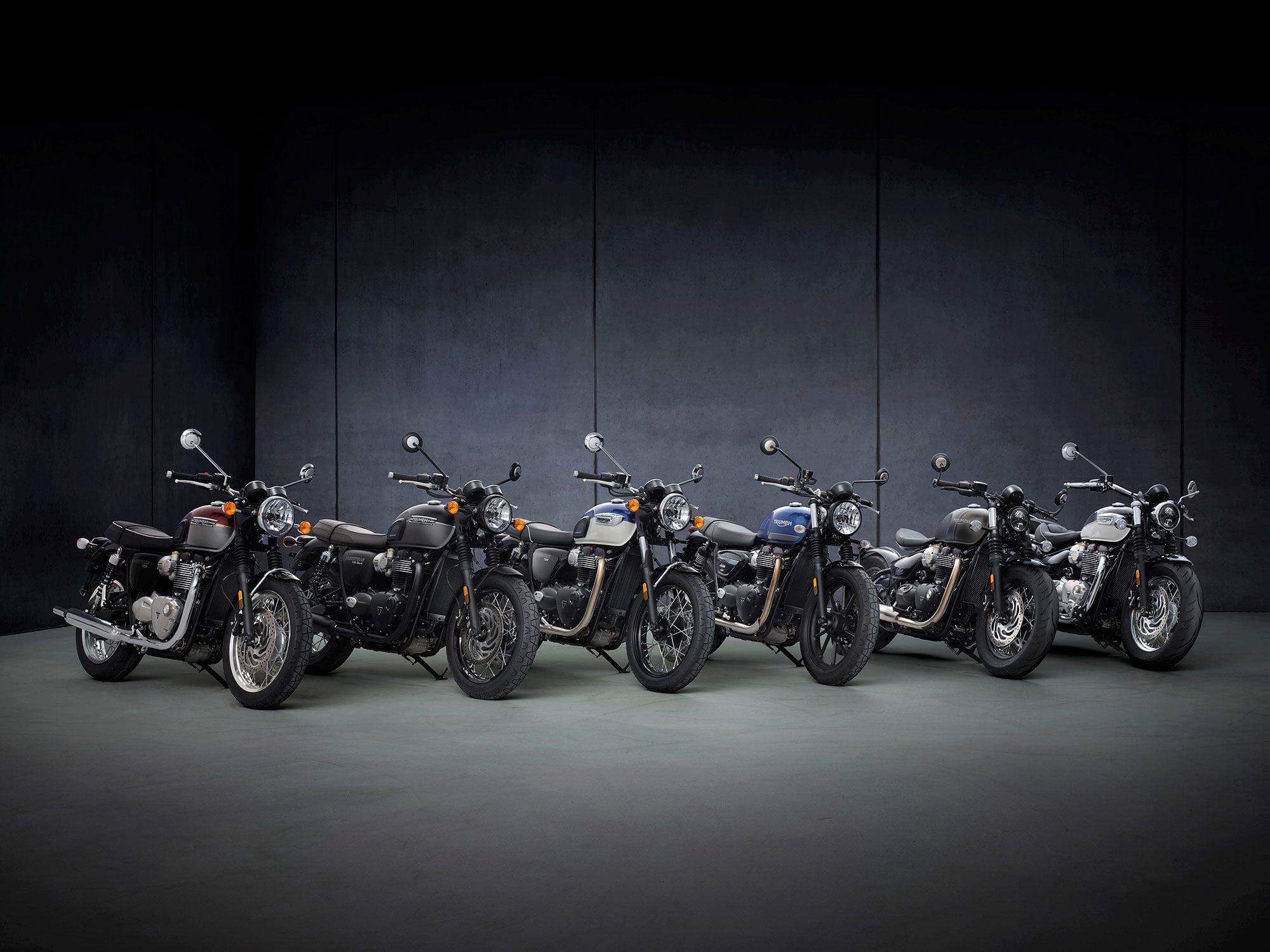
Triumph has upgraded the majority of its Bonneville family. You’re looking at seven models for 2022 so far. (Triumph Motorcycles/)When you’re updating a 60-year-old classic design for a new generation, you do so with kid gloves. A component upgrade here, a fresh coat of paint there, maybe a subtle logo update, and Bob’s your uncle. Even if that classic had a resurrection 20 years ago, you still don’t want to strip the familiarity right out of it. That was the challenge facing Triumph with its so-called Modern Classic line, which has long consisted of the best-selling Bonneville and its many variants; looming Euro 5 regulations demanded mechanical tweaks to meet emissions, and six years since the last overhaul, the series was also due for a face-lift—so Triumph did both. Enter the next generation of the Bonneville family, which in Triumph’s telling now holds seven models (though really it’s five if you take out submodels and limited editions), with the ever-recognizable Bonneville T120 still heading up the group of classic standards.
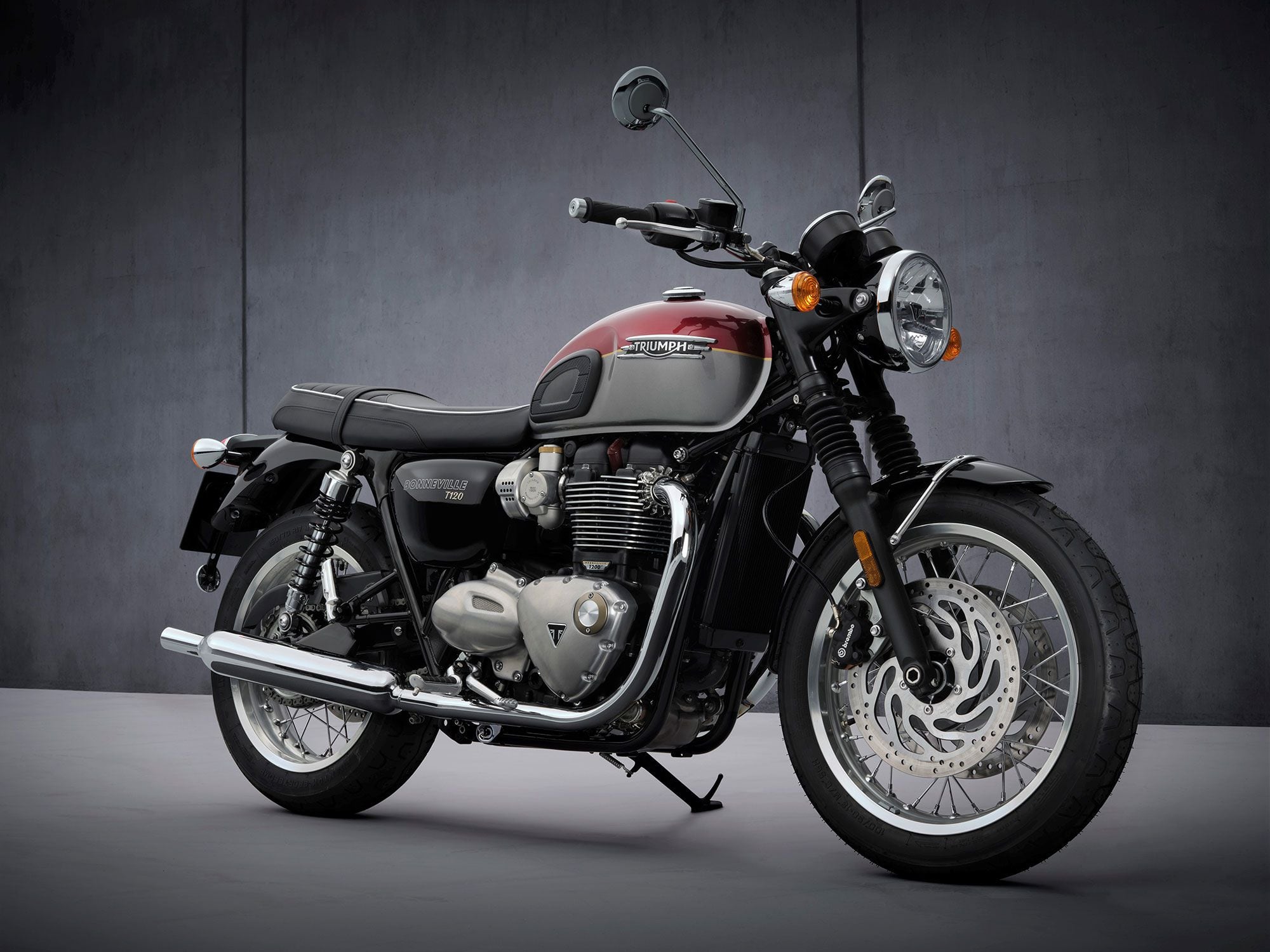
Less weight, more responsiveness, and better brakes mark the highlights for the T120. (Triumph Motorcycles/)Bonneville T120 and T120 Black
For 2022, the Bonneville range consists of the T120 (and T120 Black), their simpler T100 brother, the top-selling 900cc Street Twin offshoot, the ready-to-rumble Bonneville Bobber, and the more laid-back Bonneville Speedmaster. For the new year, they’ve all received some kind of update or improvement, many of them in the same area, and most of those incremental, whether in performance, ergonomics, refinement, or styling—or all of the above. There are no jaw-dropping reboots here, with the overall silhouettes maintaining the status quo, so when you see them on the road you’ll instantly know what you’re looking at.
The T120 flagship wheels into the new year with maybe the most subtle changes in the bunch. The classic form seems untouched and the spirited 1,200cc High-Torque parallel twin returns with performance numbers unchanged, yielding 78.9 hp and 77 pound-feet of torque on the Triumph spec sheet. But the Brits utilized a bit of weight reduction trickery within, giving the T120 a lighter crankshaft and tweaking the clutch and balancer shafts to reduce inertia, thus imbuing the engine with more responsive feel. Keeping that theme was the addition of lighter aluminum wheel rims, which Triumph says contributes to more agile steering; in all total weight reduction is a not insubstantial 15.5 pounds.
RELATED: New Triumph Street Scrambler Sandstorm Coming for 2022
The added responsiveness is tempered by a corresponding upgrade in the stopping department, thanks to higher-spec calipers and discs from Brembo. The T120′s new twin-piston sliding axial front calipers act on twin 310mm discs, paired with a single-piston floating caliper and 255mm disc out back. Braking performance is no doubt even further bolstered by the fact that the new bike weighs that much less too.
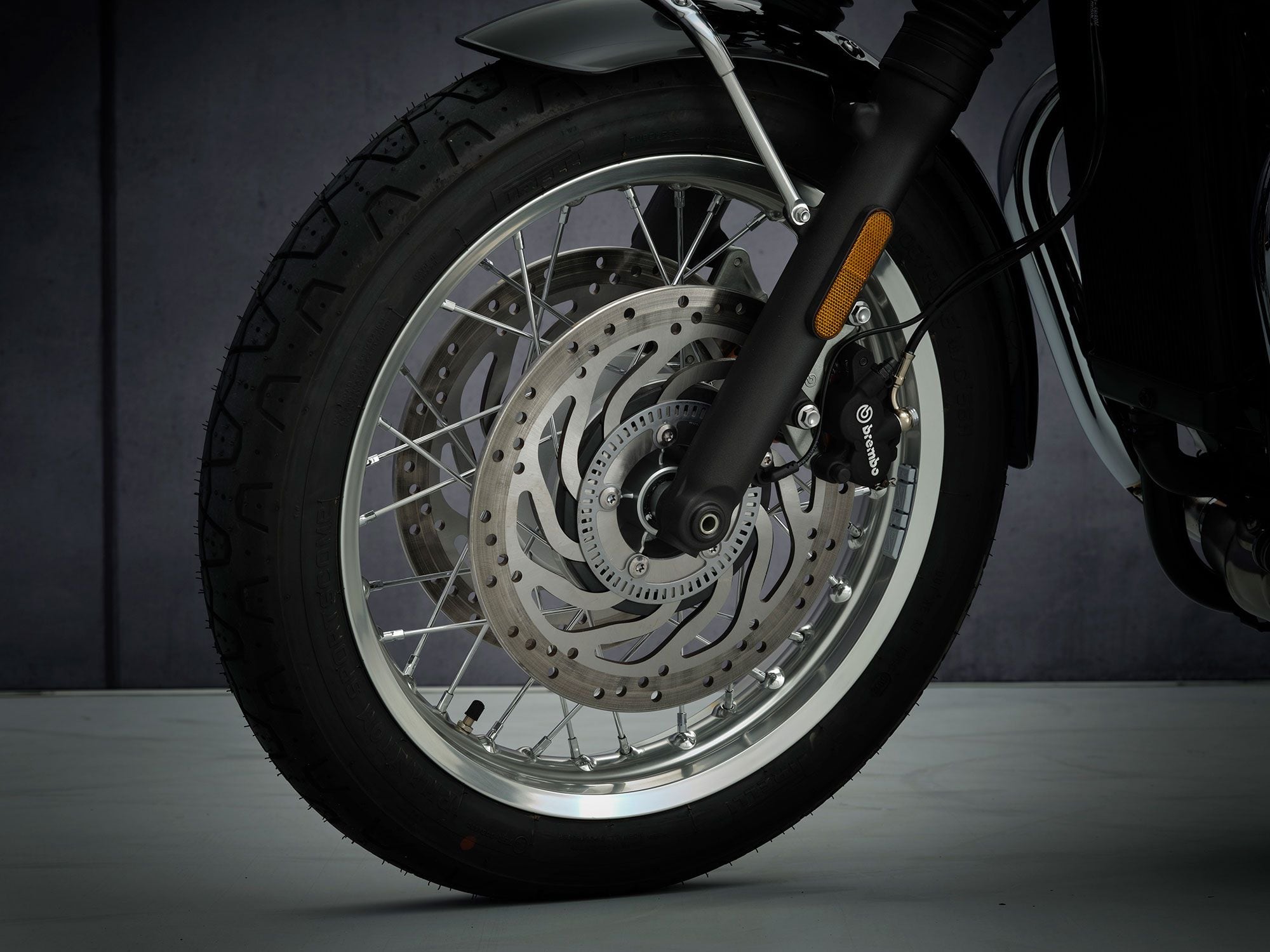
The twin discs are unchanged, but new Brembo calipers improve stopping performance. (Triumph Motorcycles/)Convenience matters, so Triumph added cruise control as a standard feature and enhanced the selectable standard rider modes, now allowing adjustment to the throttle map as well as traction control settings. More subtle changes onboard are the addition of new 3-D chromed tank badges, as well as a fresh instrument arrangement with 3-D dial faces and new display features (including access to turn off traction control). After that, details really get slight, with things like new machined fins on the engine and more chrome finishes and contrast piping on the seat.
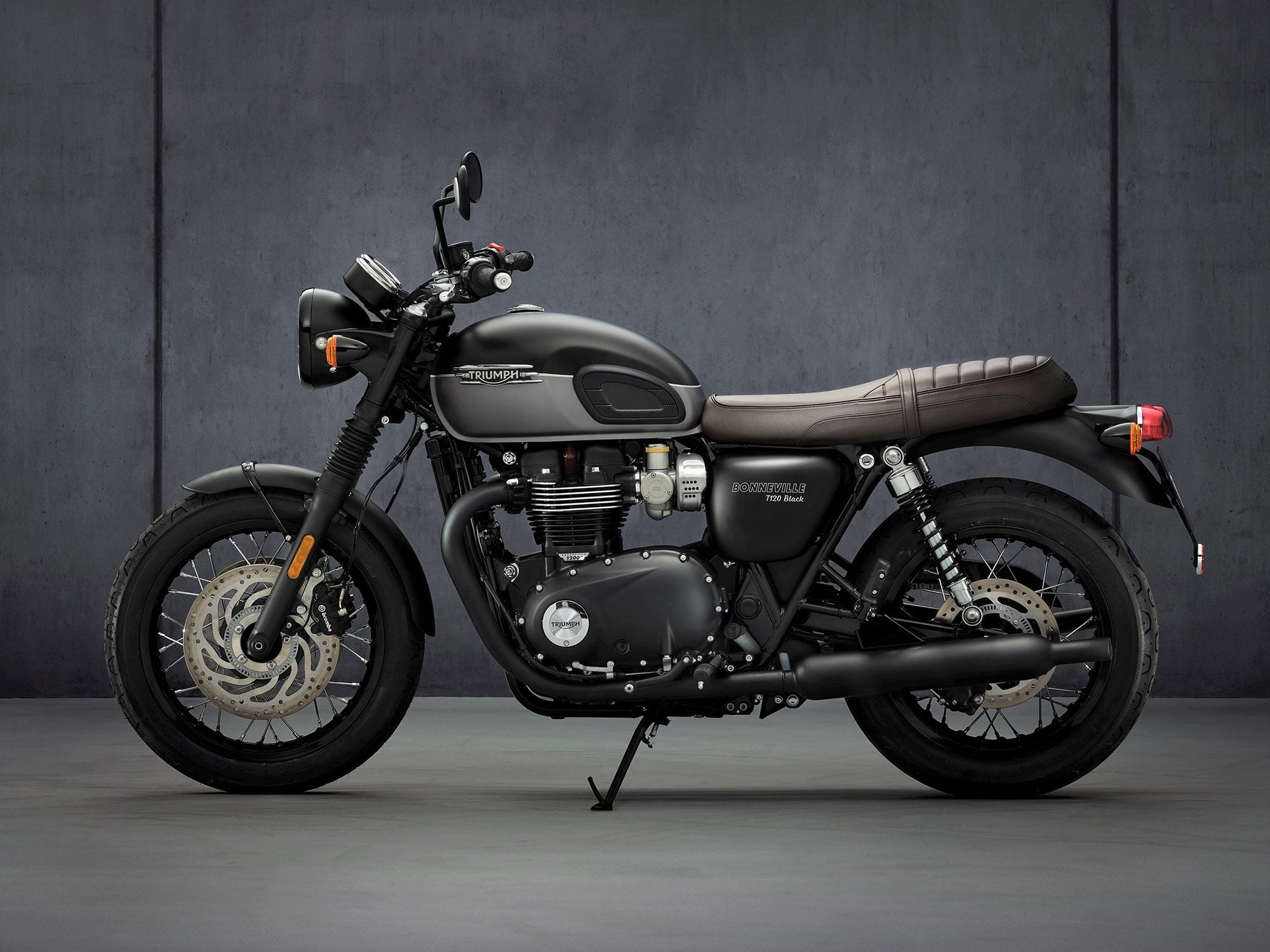
The 2022 T120 Black gets the same subtle changes: less weight, less inertia, snappier engine. Cruise control is now standard. (Triumph Motorcycles/)With the T120 Black, it’s more of the same; take the base T120 and literally just paint it black, dabbing the wheel engine covers, mirrors, headlamp bucket, and exhaust in the dark stuff. Unless you’re talking about the unique dark brown seat, you’ll see pretty much the same upgrades here as on the standard T120, with the lighter wheels and beefier brakes below, and new instrument faces and badges up top.
Perhaps more impressive is that with just some minor juggling of cam profiles and exhaust revisions, Triumph was able to get the relatively unchanged 1,200cc engine to produce fewer emissions and meet Euro 5 requirements, with hydrocarbons to spare.
The new 2022 Bonneville T120 will be available in black, red/silver, and blue/silver (with hand-painted gold lining on the two-tone bikes) and the T120 Black can be had in black or black/gray (with silver lining on the latter). Both models are coming to North America starting May 2021 and will be priced at $12,050 USD.
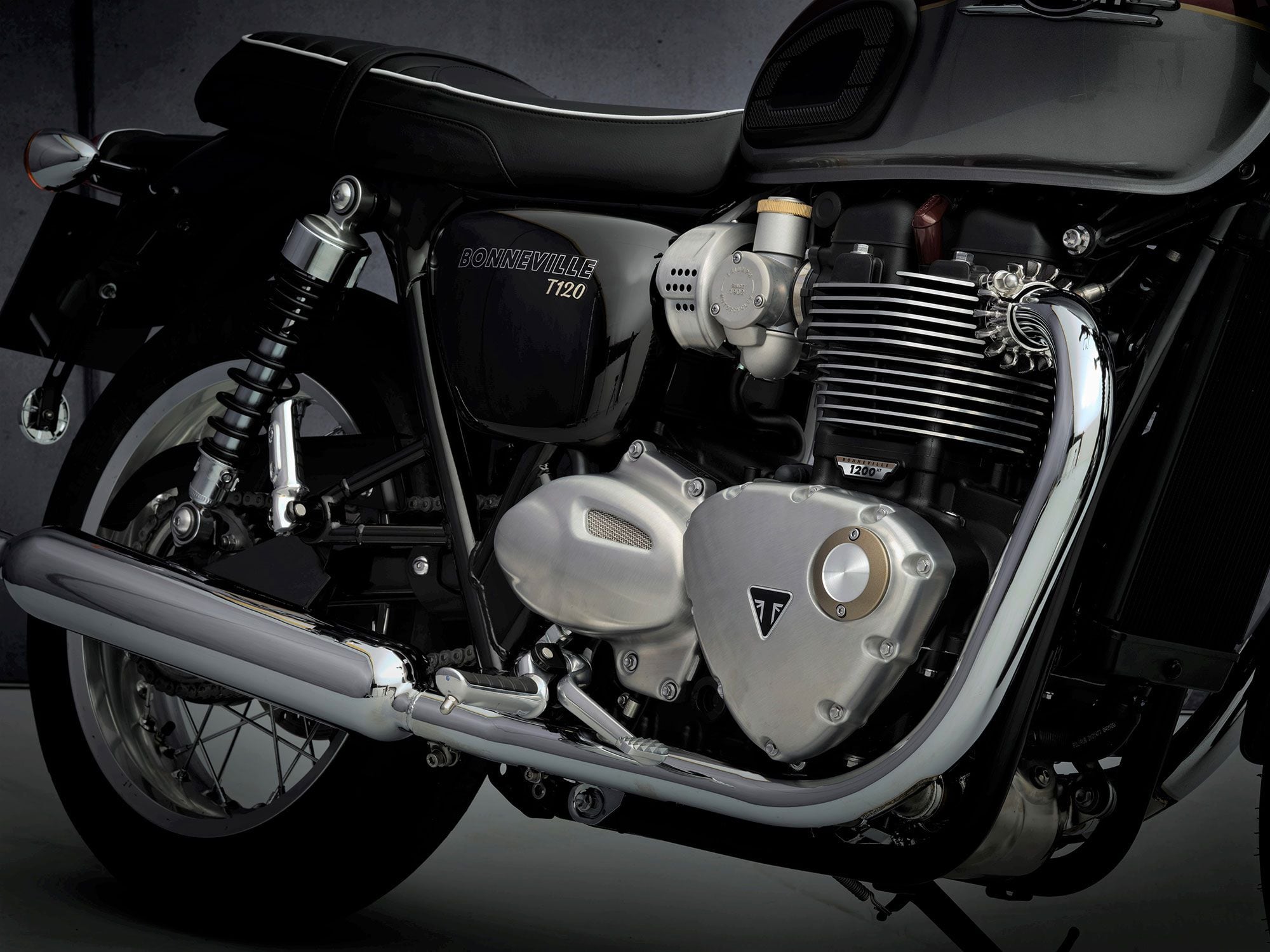
With a combination of changing cam profiles and revised porting, Triumph was able to meet Euro 5 emissions requirements. (Triumph Motorcycles/)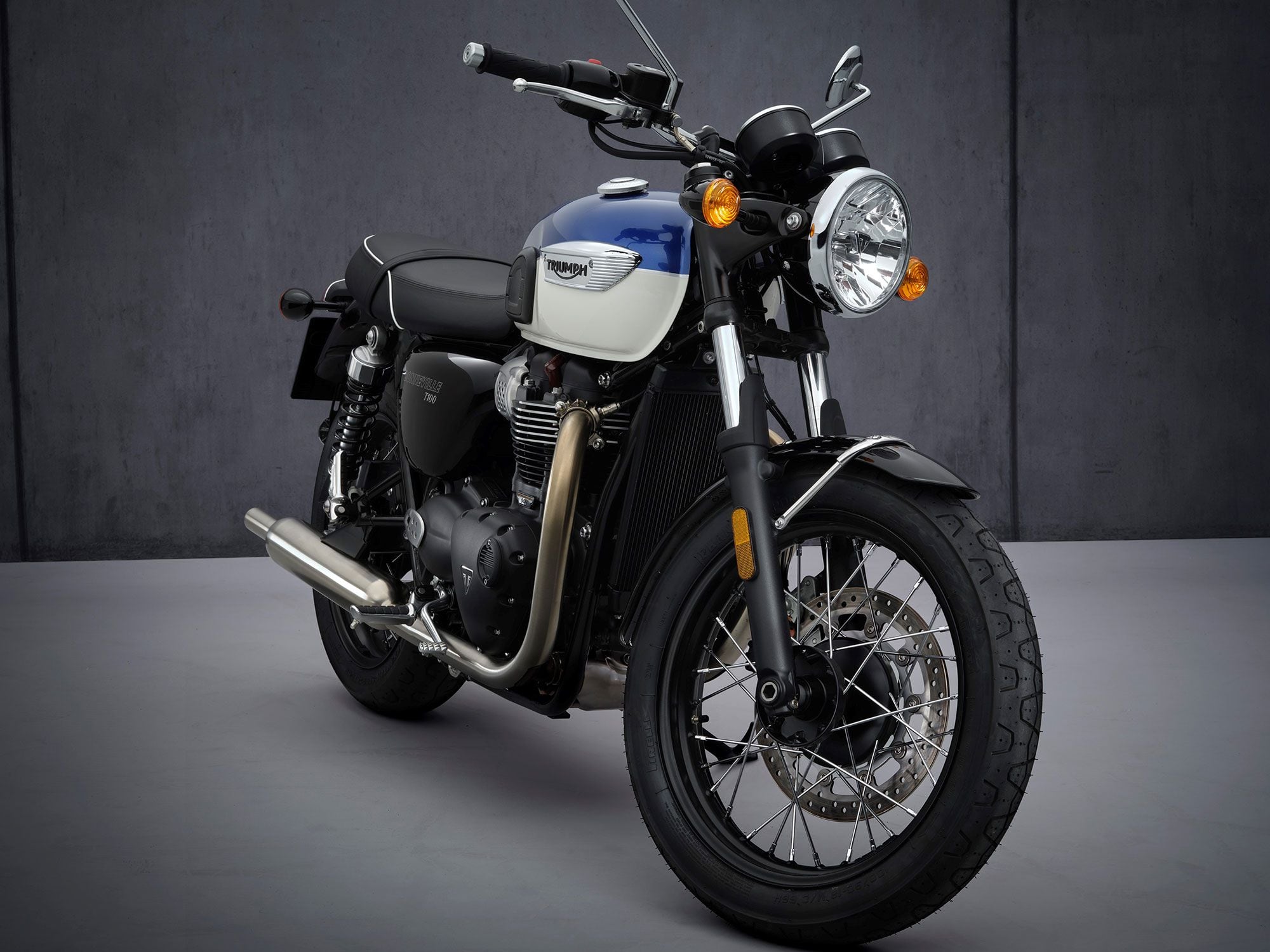
The 2022 T100 still rolls with the 900cc HT engine, but it gains 10 hp. It also adds a new cartridge fork and upgraded brake calipers. (Triumph Motorcycles/)Bonneville T100
The T120 gets all the love, but really, the T100 is the one that channeled the 1959 icon first. Alas there’s no Black version this year (or a Bud Ekins edition, for that matter), but the 900cc classic still gets its share of performance tweaks and sleights of hand in the styling department. In fact, the 2022 T100 gets 10 more horses and is nearly 9 pounds lighter than its predecessor, in addition to receiving upgraded brakes and a new cartridge fork. Triumph lists the engine rating as 64 hp at 7,400 rpm, with higher power across the rev range, and a 500 rpm higher rev limit to boot. The torque peak of 59 pound-feet remains unchanged from the previous model, though on the new T100 the peak now arrives at a later 3,750 rpm. Again, Triumph credits a lighter-weight crankshaft, clutch and balance shafts as well as magnesium cam covers and revised ports and cam profiles for the boost in power and responsiveness. The engine is also now fully Euro 5 compliant, thanks partially to a secondary air system.
The T100 gets the same upgrade to its brake system as its higher-spec brother, with new Brembo calipers to improve bite, though it does retain the same wheel and tire sizes from last year. A new higher-spec 41mm cartridge fork also makes the scene, and the T100 seems a bit sleeker this time around, perhaps because it no longer wears rubber gaiters around the fork legs. Other elements of the bike have been blacked out as well, including the engine, cam, and sprocket covers—and we all know black is slimming. On the instrument side, there’s a new dial face, and ABS and switchable traction control come standard.
The 2022 Bonneville T100 will come to these North American shores starting March 2021, in a choice of black, red/white, and blue/white, any of which will lighten your wallet to the tune of $10,500.
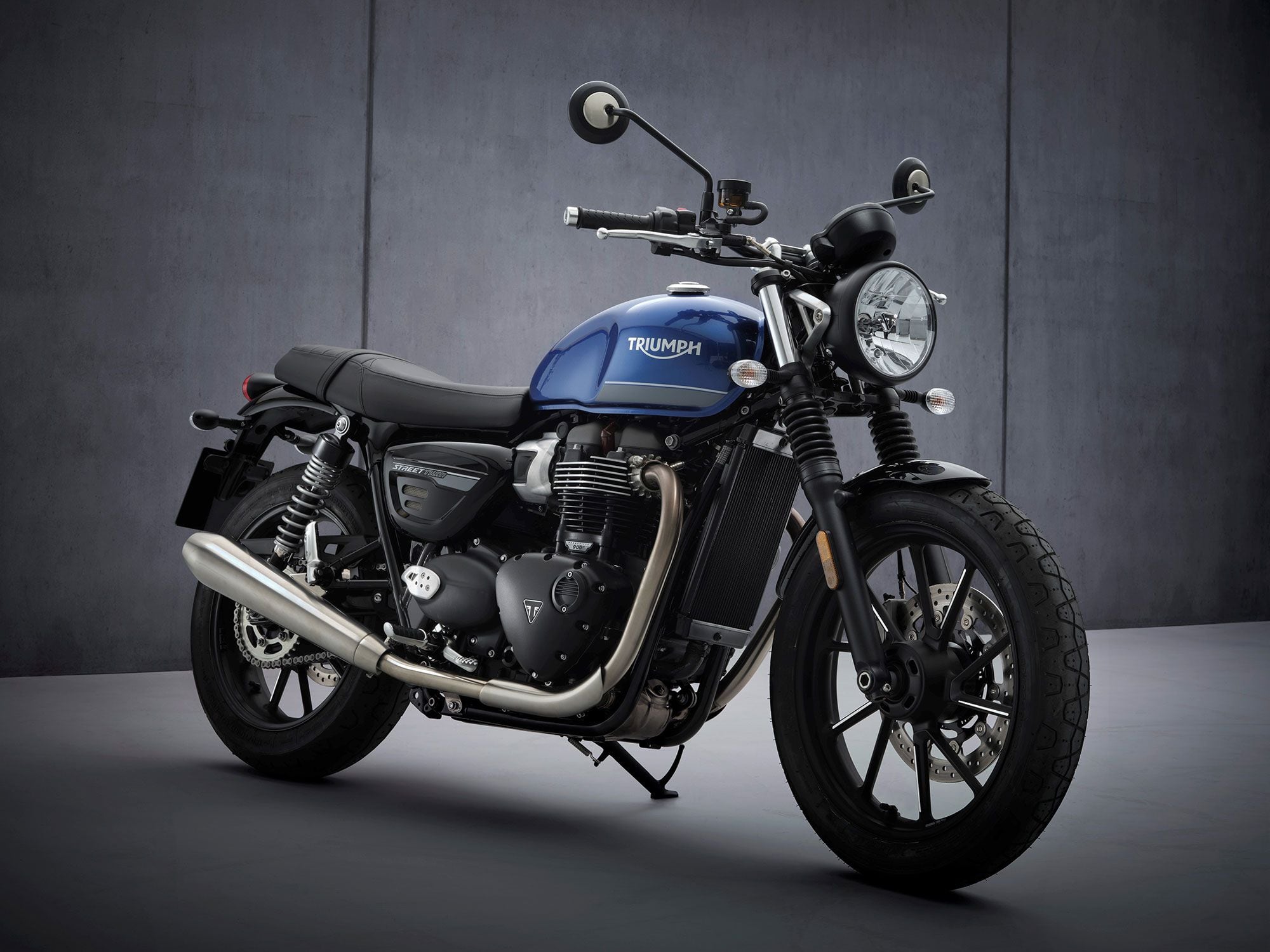
Changes on the 2022 Street Twin include lower emissions, new cast wheels, and ribbed bench seat. (Triumph Motorcycles/)Street Twin
Triumph’s best seller in the Modern Classics line for the last few years running is back for 2022 and, short of a few minor styling and comfort boosts, heaves into view relatively unchanged. But then why would it be? The 900cc model has been a bona fide hit from Day One and after some fairly major updates in 2018, there isn’t much to fix this time around. Same 41mm cartridge fork, same 65 hp, 900cc high-torque engine, same Brembo brakes, same ABS and traction control. Of course it’s now Euro 5 compliant, but Triumph has seen fit to leave pretty much everything else alone, opting to embellish the Street Twin with new, stylish, 10-spoke cast wheels with machined details as perhaps the most noticeable change. A more shapely ribbed bench seat with thicker foam, new throttle body finishers, aluminum headlight brackets, and new tank decals round out the list of cosmetic touches, but otherwise the Street Twin keeps all of its goodness intact for 2022.
RELATED: How Much Power Does the 2020 Triumph Street Twin Make?
The new 2022 Street Twin will be available in black, blue, and Matt Ironstone (the latter with new stripe detailing) in North America starting in March 2021. The price remains pretty right as well, handily coming in under the $10K line at a suggested $9,400 USD.
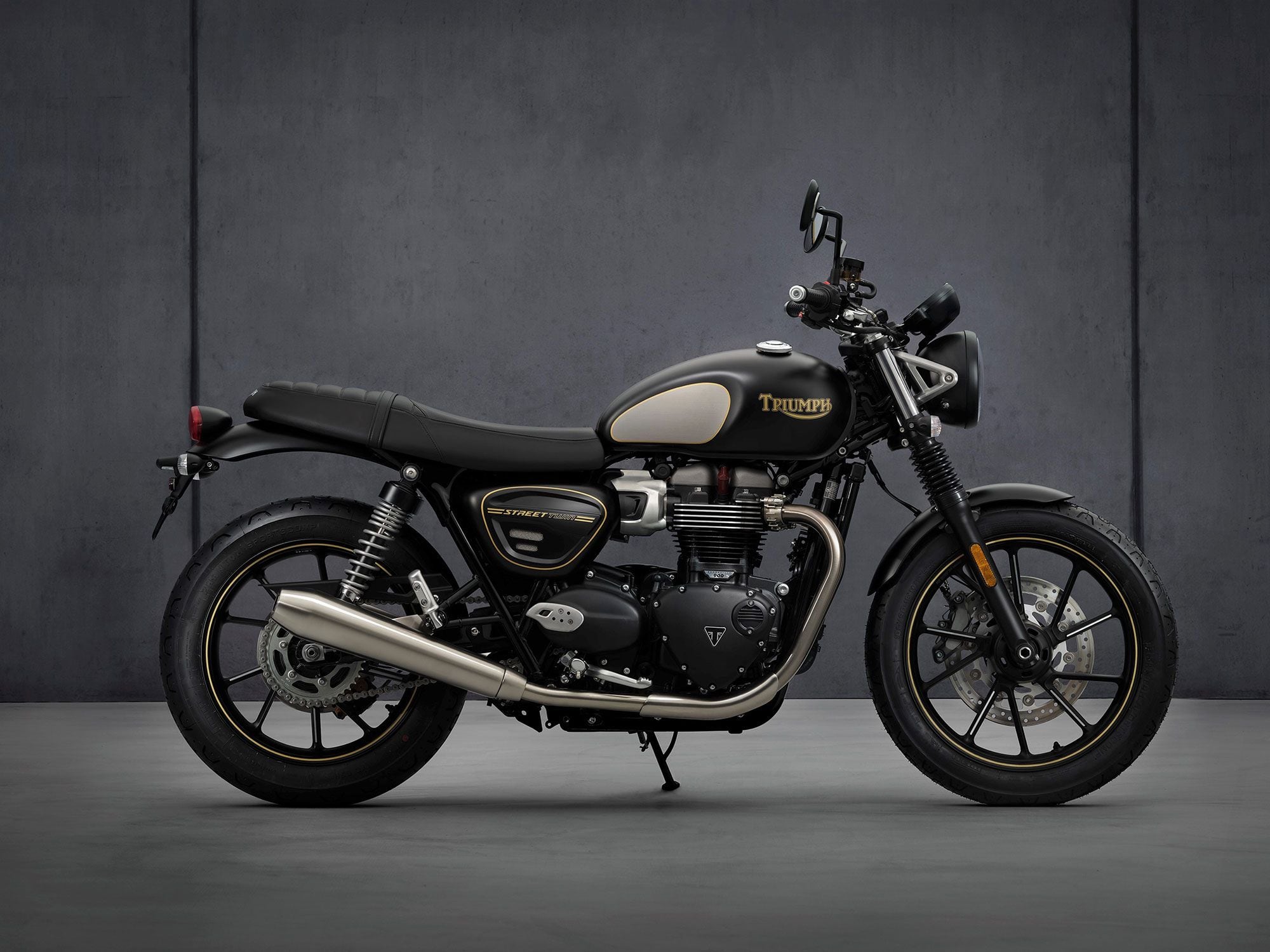
The limited-edition Street Twin Gold Line Twin boasts a hand-painted black and gold color scheme. Only 1,000 are available. (Triumph Motorcycles/)Street Twin Gold Line
Joining the Bonneville series as a new model for 2022 is the Street Twin Gold Line, a limited-edition variant of the straight Street Twin that Triumph considers a stand-alone model. The hand-detailed custom special is pretty slick looking on the outside, featuring a classy matt black and gold paint scheme straight from Triumph’s expert color shop. The wheels are framed in thin elegant pinstripes, the tank logo is painted—even the knee pads are brushed. A hand-painted Gold Line edition-special side panel with custom logo decal IDs the bike for all to see, and only 1,000 editions of the bike will be produced worldwide, each coming with a certificate of authenticity.
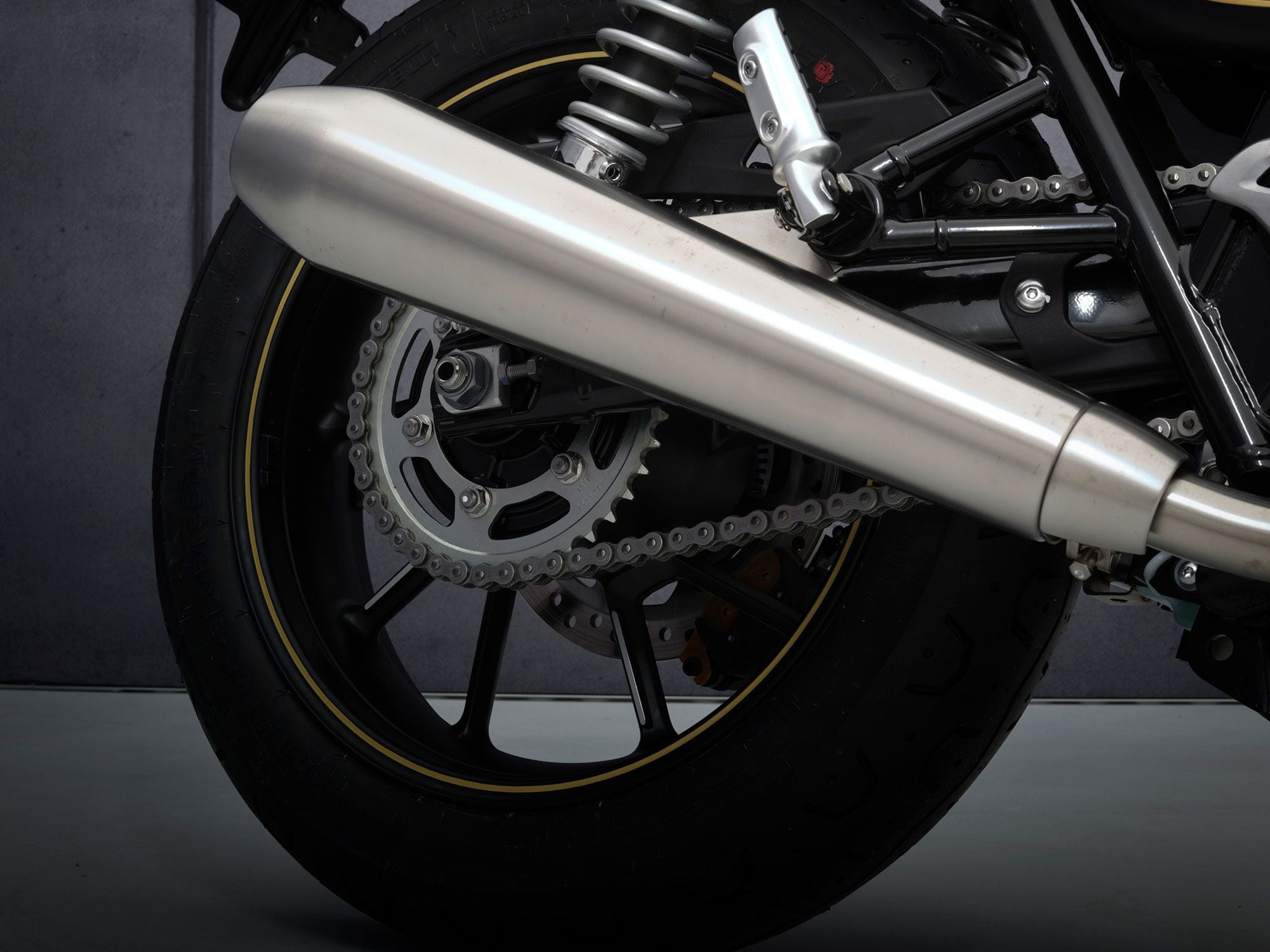
Underneath the gold and black paint is a mostly stock Street Twin. (Triumph Motorcycles/)The Street Twin Gold Line also receives the same accents and styling tweaks as the standard 2021 Street Twin, which means the 10-spoke cast wheels with machined highlights (though these wear those fancy pinstripes), new ribbed bench seat, headlight brackets, and aluminum throttle body finishers, but underneath, it’s the same now-Euro 5-compliant base model. Which is not a bad thing, though we’d like to have seen a few more unique components to further distinguish the limited edition from its closely related stock brother. The Gold Line models will be here in June of 2021; price is yet to be announced.
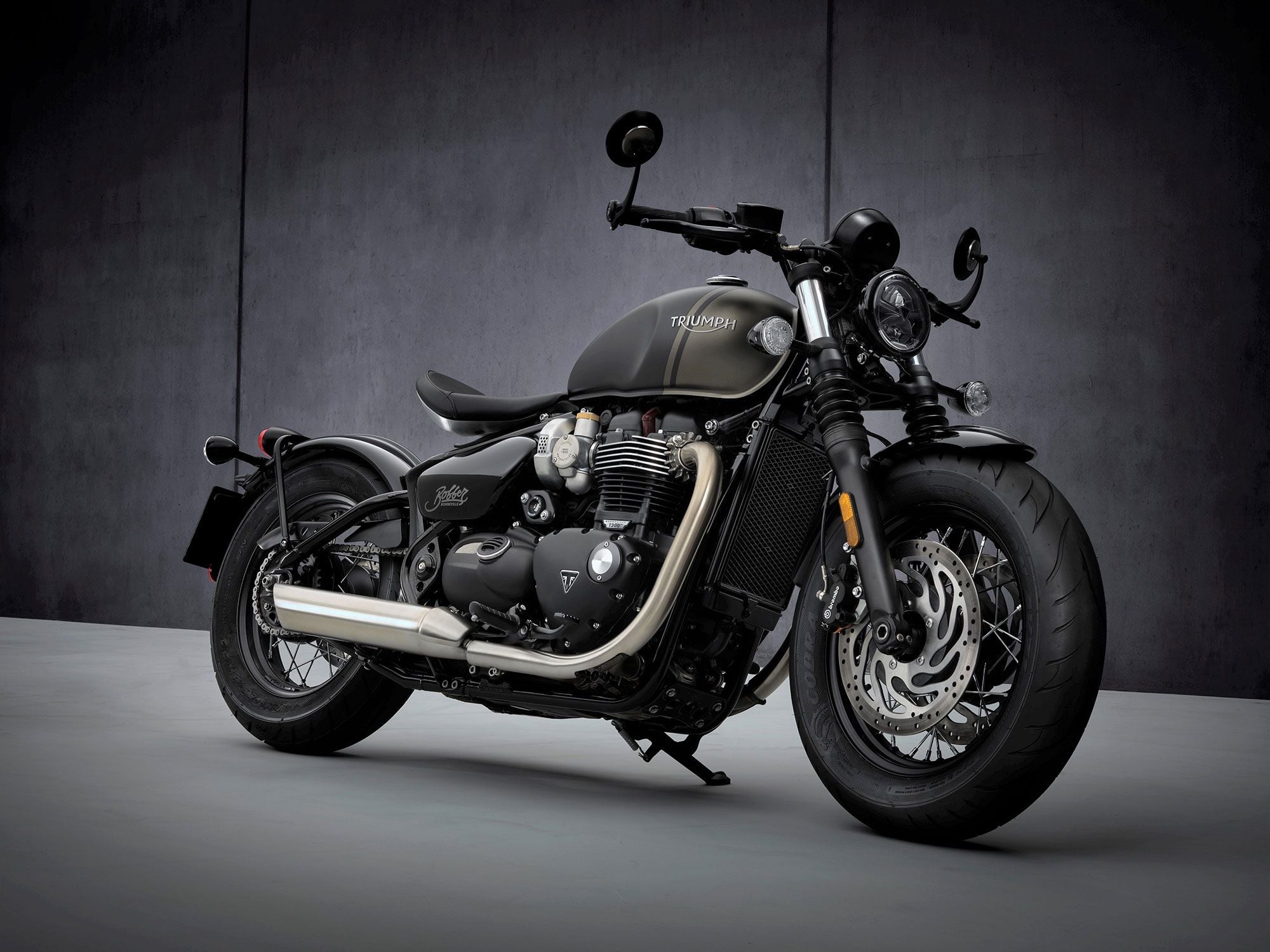
There’s just one Bobber model in the Triumph range this year, combining the best bits of both of the 2020 models. So long, Bobber Black. (Triumph Motorcycles/)Bonneville Bobber
Triumph dabbles in another bit of consolidation for the Bobber series, with just one Bobber model representing the line for 2022. Triumph says the move was made easier for the fact that the 16-inch fat tire Black model was by far the better seller, giving us the model we see here for 2022, which merges the best qualities of both models. The upgraded and refined 2022 Triumph Bonneville Bobber carries over some of the black model’s darker elements naturally, but like most of the other new bikes here, it too gets better brakes and lighting upgrades, a more responsive 1,200cc high-torque engine (performance is unchanged though Triumph claims a flatter torque curve), and yep, it also meets Euro 5 requirements.
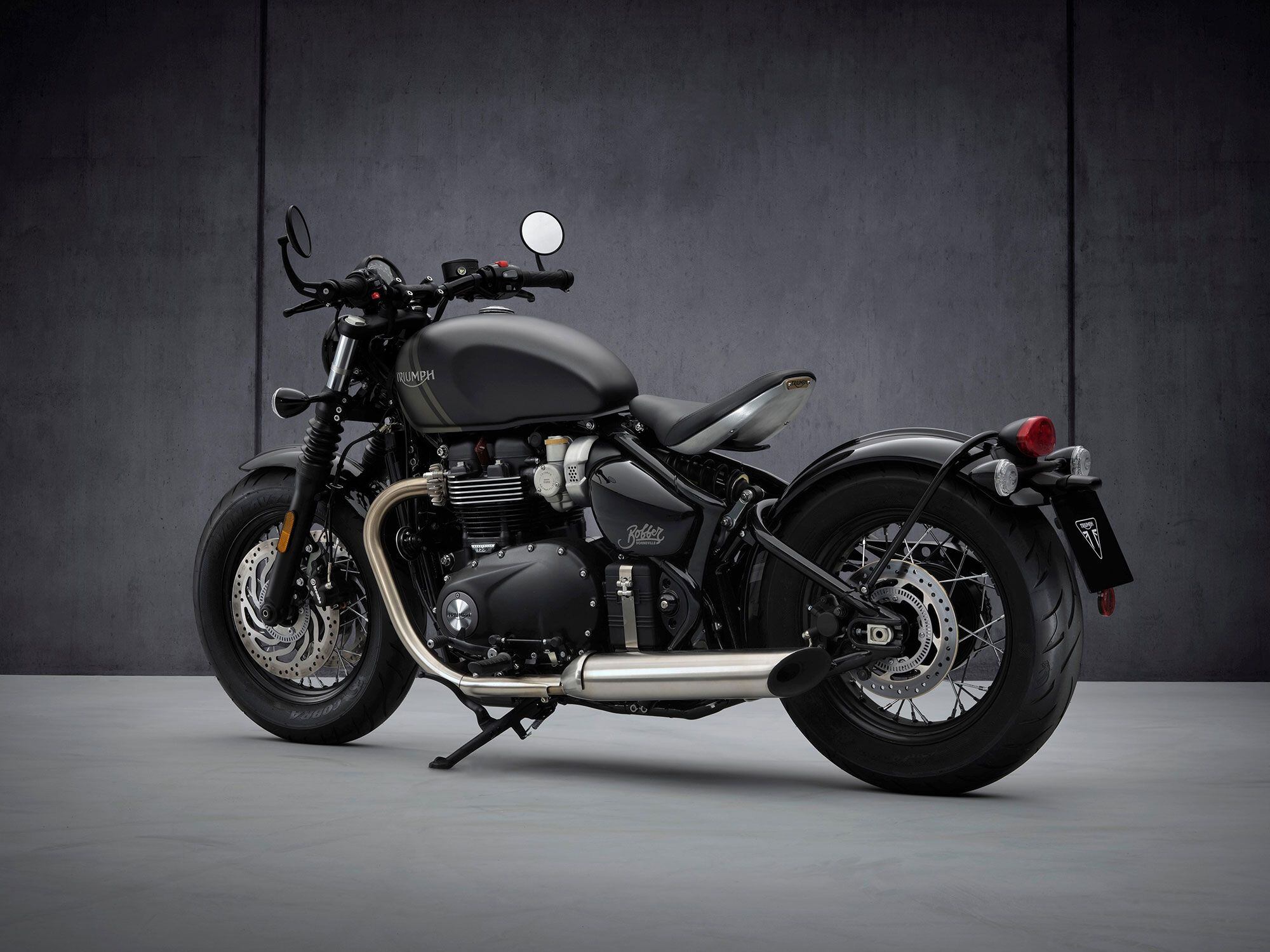
Fat 16-inch tires, a bigger fuel tank, and a higher-spec 47mm fork make the spec list this year. (Triumph Motorcycles/)But it’s not all emissions and styling; the Bobber adds a few more upgrades as well, like a larger 12-liter fuel tank (still only 3.2 gallons). Triumph also gives the new 2022 Bobber a higher-spec 47mm Showa fork, Brembo brake discs and calipers, and cruise control now added as standard feature, with all those components trickling down from the (previously) higher-spec Black model—along with that fat 16-inch front tire. Triumph added a few stylish tweaks in the form of black powdercoated engine cam and sprocket covers, and you also get an LED headlight with DRL, ABS, and switchable traction control as well as the slick adjustable solo seat to marry old-school cool with modern safety features.
The sole Bobber in the line will come in black, new Matt Storm Grey/Matt Ironstone, and red when it hits North America in March 2021, retailing for $13,150 USD.
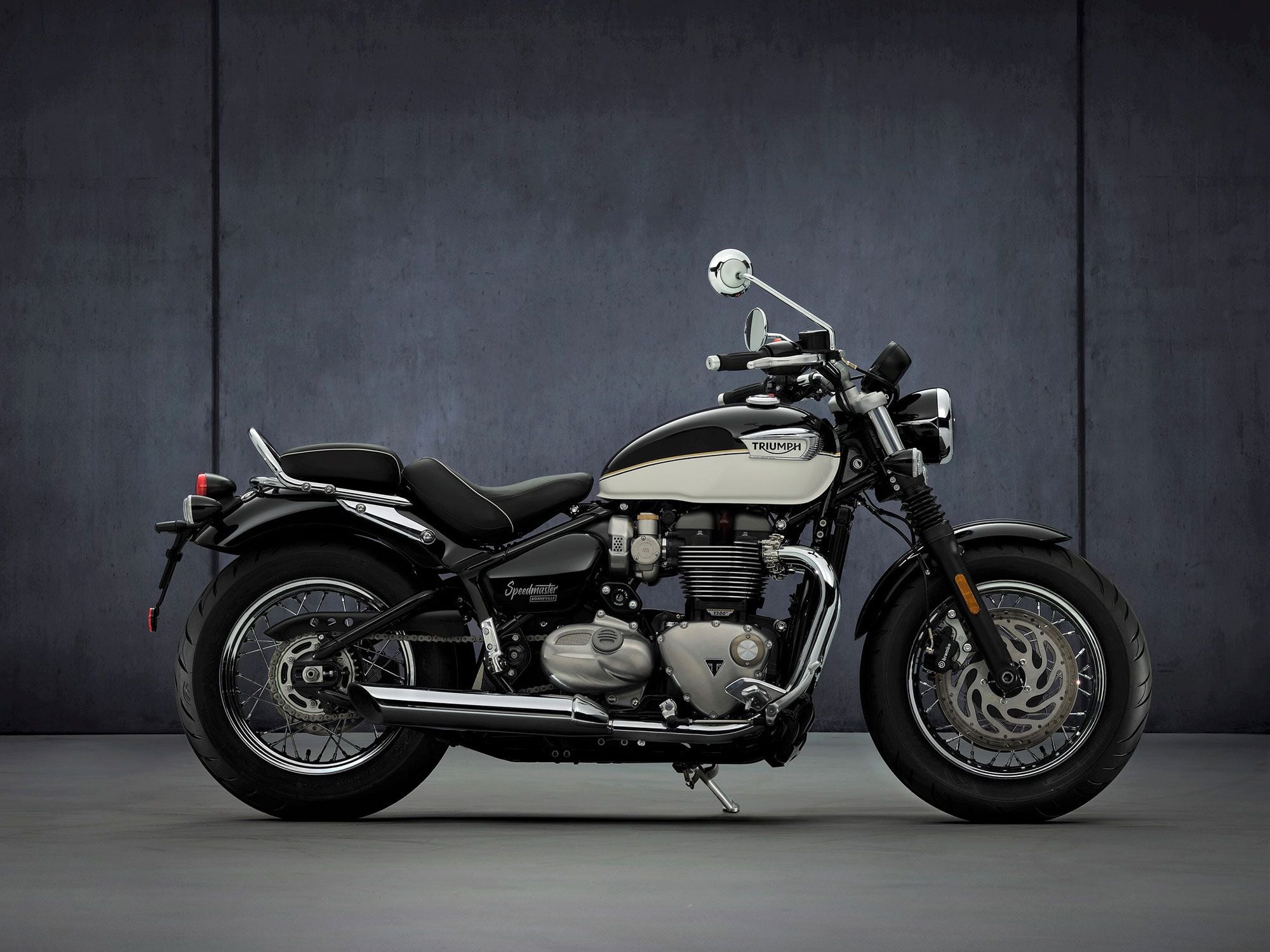
The Speedmaster cruiser also refines engine response, adds a 47mm fork, and revamps the seat for more comfort. (Triumph Motorcycles/)Bonneville Speedmaster
The one true unashamedly cruiser-ish rig in the range is the laid-back, über-comfy Speedmaster, coming at you with fat tires, a plush two-up seat, and most of the other upgrades you’ve been reading about above, including a more responsive 1,200cc HT engine with lower inertia and lower emissions, that’s now also Euro 5 compliant.
Triumph says the engine’s peak power and torque numbers are unchanged (78 bhp peak power) but their curves are somewhat flatter, for more accessible power that lasts later in the rev range. To that, the Speedmaster also adds higher-spec 47mm Showa fork with 90mm of wheel travel for 2022, and a new more comfortable saddle with improved rider and pillion sections featuring thicker foam. You’ll also see a new dial face on the single instrument gauge which is likewise enclosed in a new bezel. Like the Bobber, the Speedmaster wears chunky 16-inch tires and comes with two ride modes, ABS and traction control, a full LED headlight, and cruise control as standard.
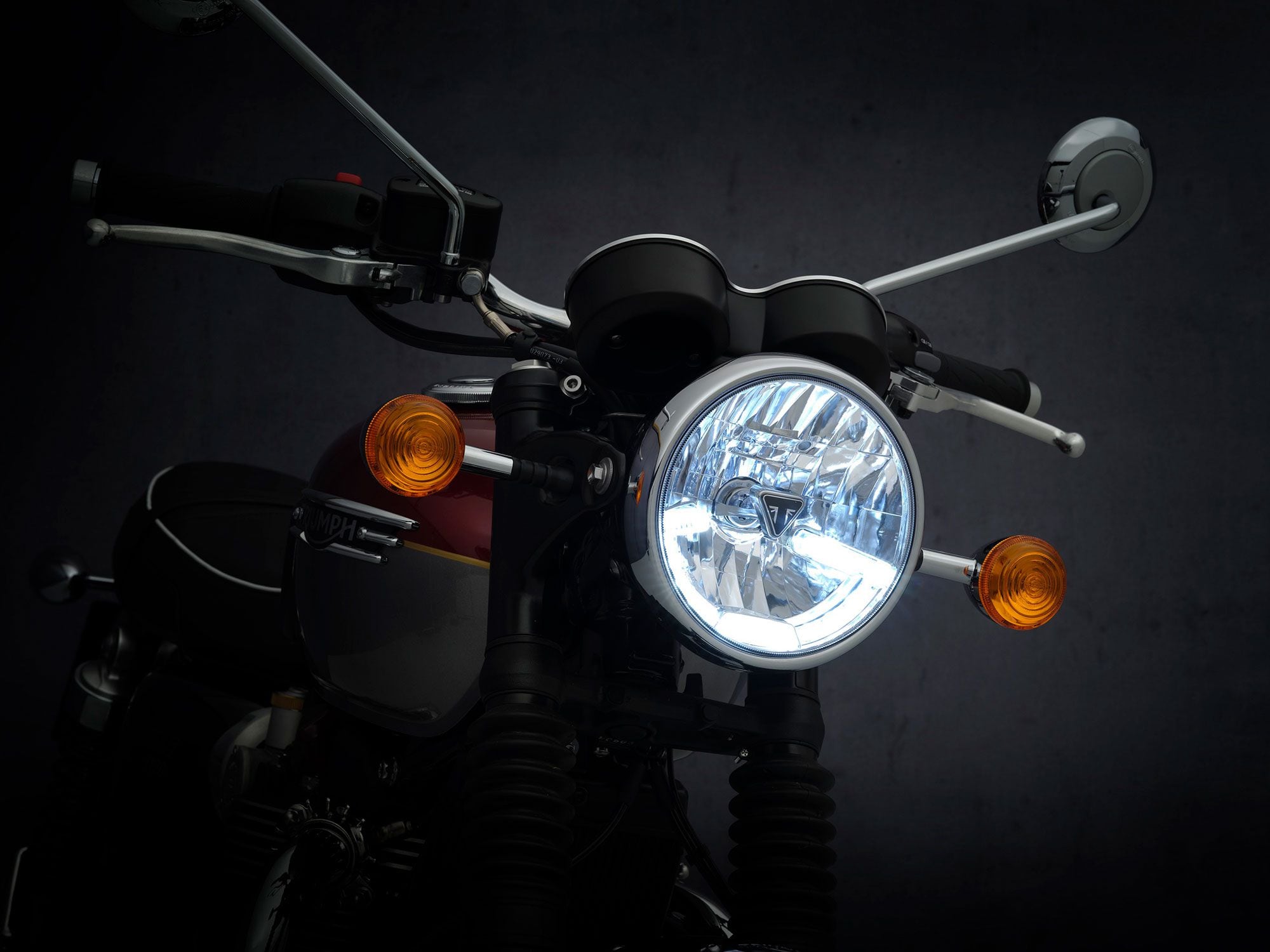
Full LED headlights, some with DRL, are featured on most of the new 2022 Bonneville range. (Triumph Motorcycles/)It’ll be available in black, as well as new colors including red and white/black. The Speedmaster will be in North America starting March 2021, with an MSRP of $13,150 USD.
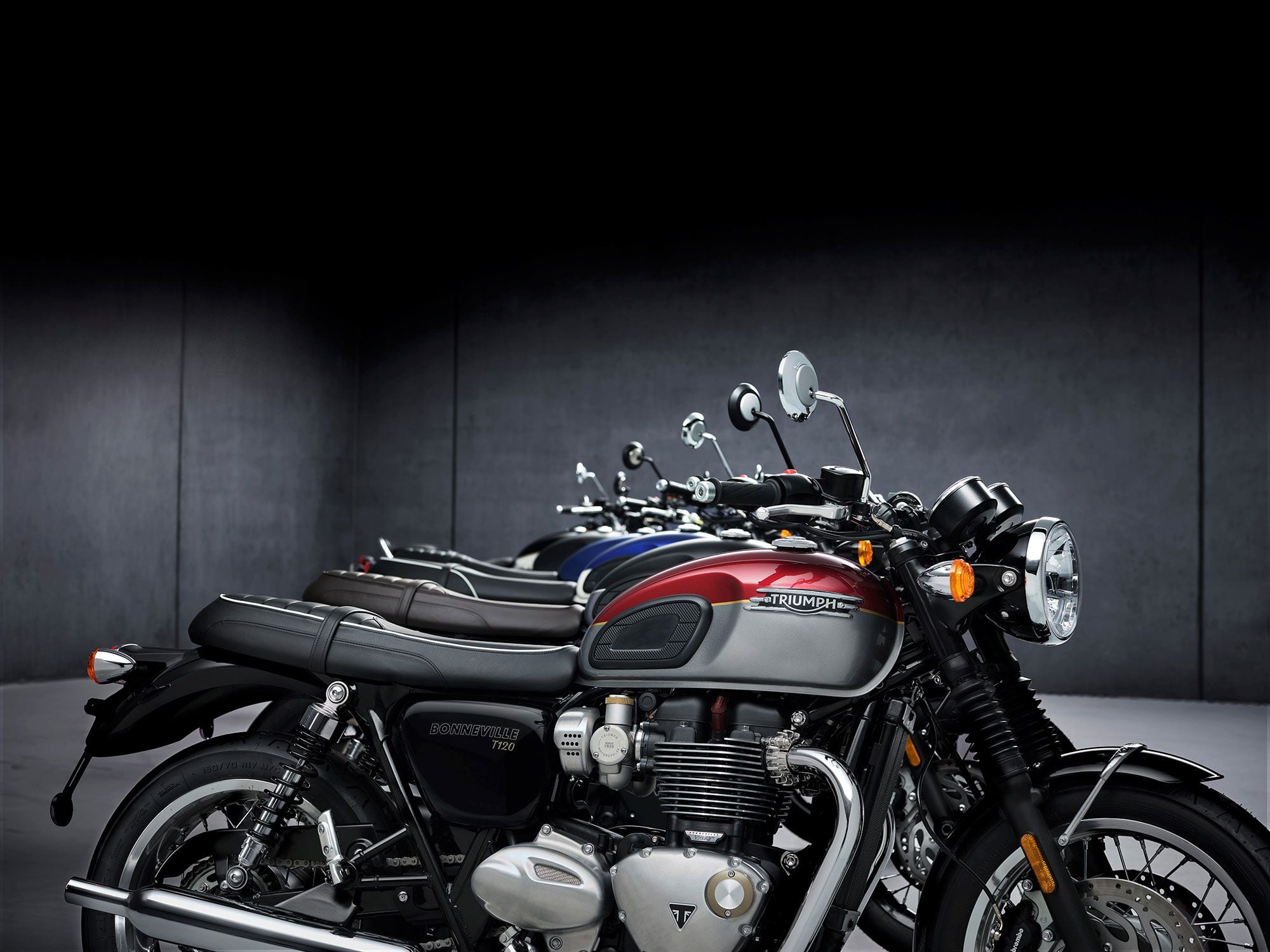
Most of the 2022 model year bikes will be available by May or June at the latest. (Triumph Motorcycles/)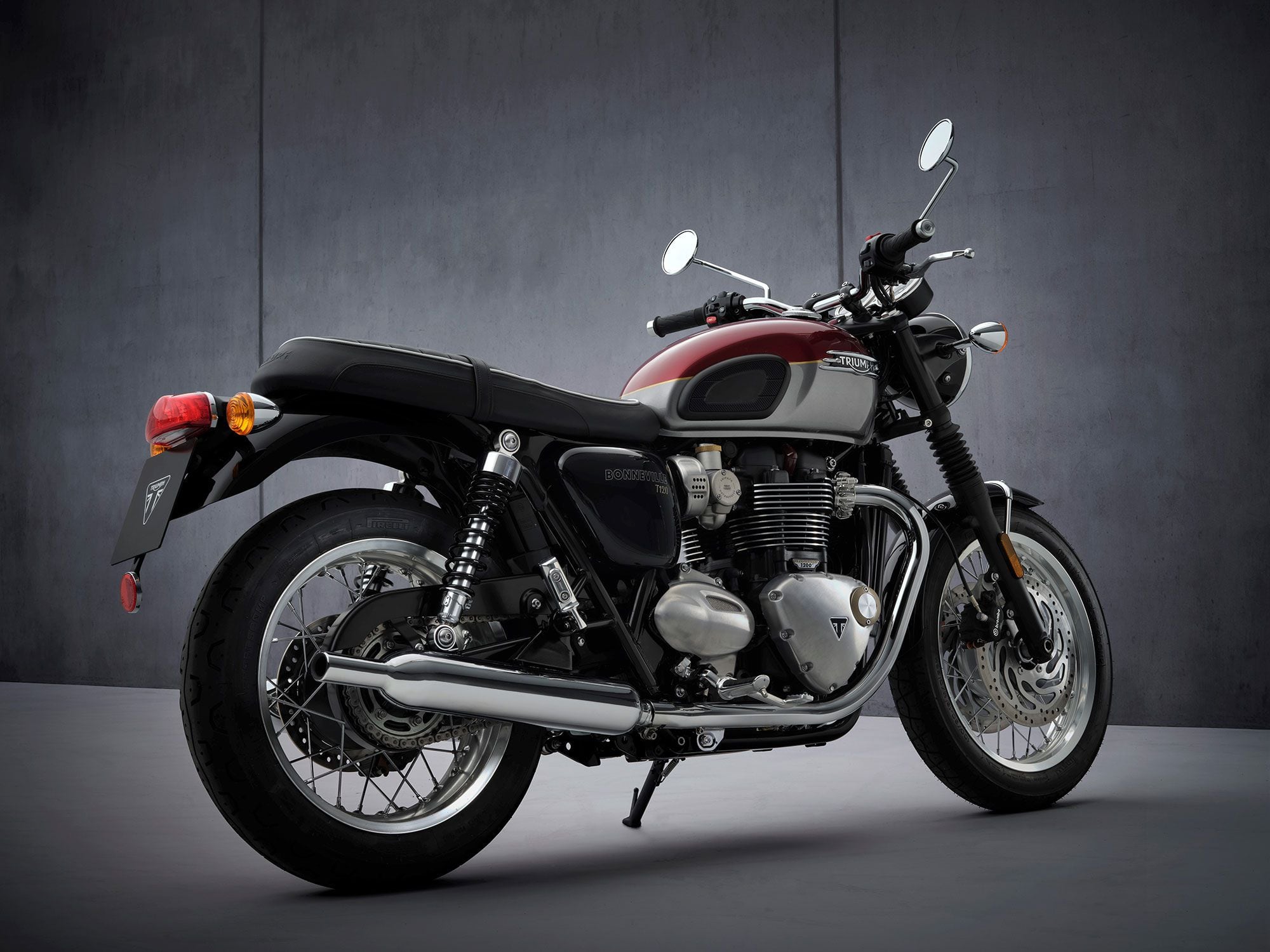
The 2022 Triumph Bonneville T120 from the rear. (Triumph Motorcycles/)If you’re wondering about the Thruxton line, well the new RS launched last year, and the official reveal of the new-generation Scrambler 1200 models as well as the Street Scrambler will come in April 2021. No word as yet on if the Speed Twin will get any redos for 2022, but we’ll let you know as soon as we do.
-
-
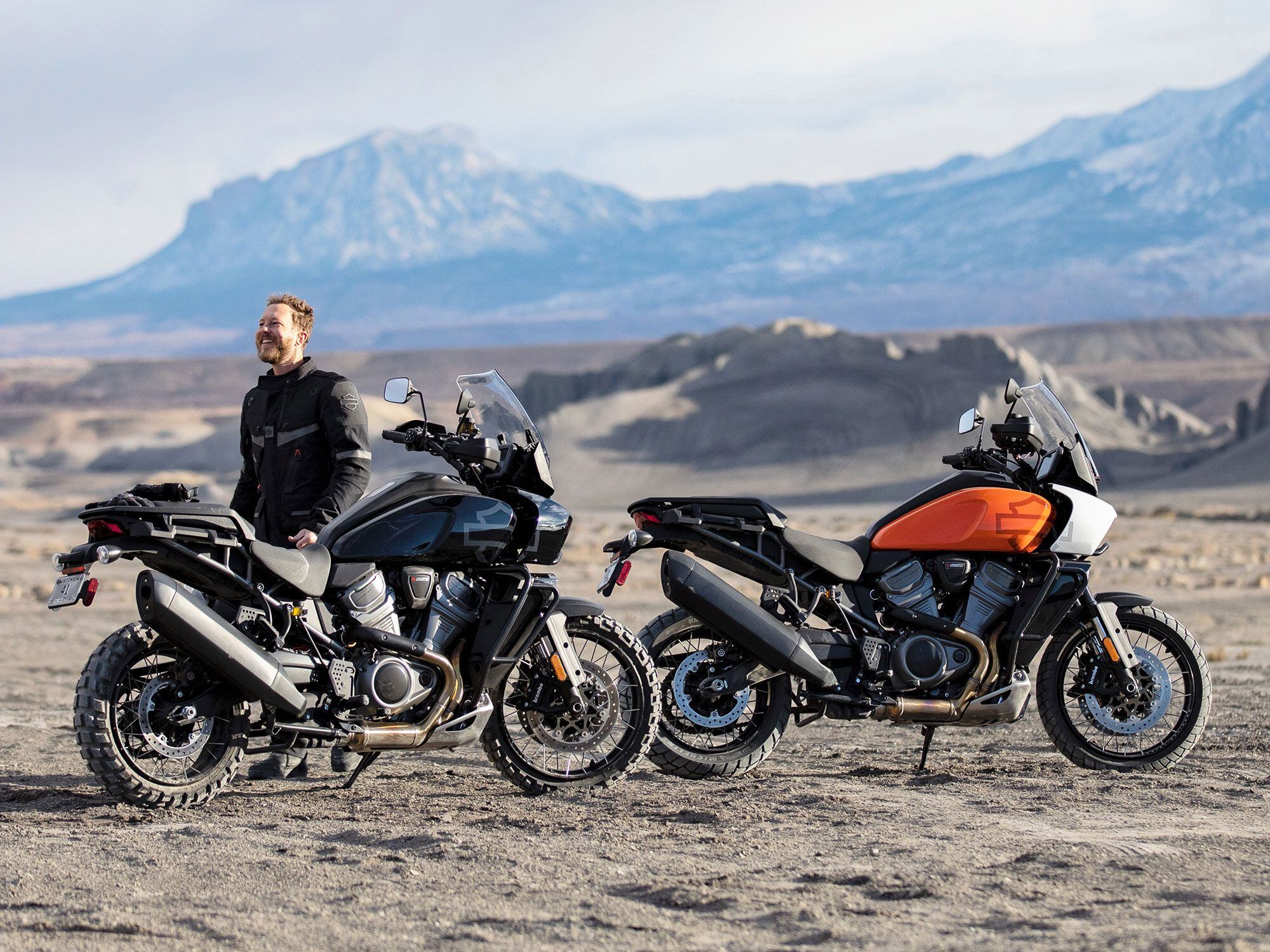
The Pan America has been revealed in two versions, the base 1250 and the better-equipped 1250 Special. (Harley-Davidson/) We’ve waited more than a year for it, but Harley-Davidson’s long-buzzed-about Pan America is now out in the world, and we can finally get around to chatting about the details of H-D’s very first adventure bike. Our own Technical Editor Kevin Cameron assembled a hugely informative big picture First Look into the 2021 Harley Davidson Pan America 1250, so you may want to check that out before going any further. Otherwise, let’s look at the differences between the base-model 1250 and the higher-spec 1250 Special.
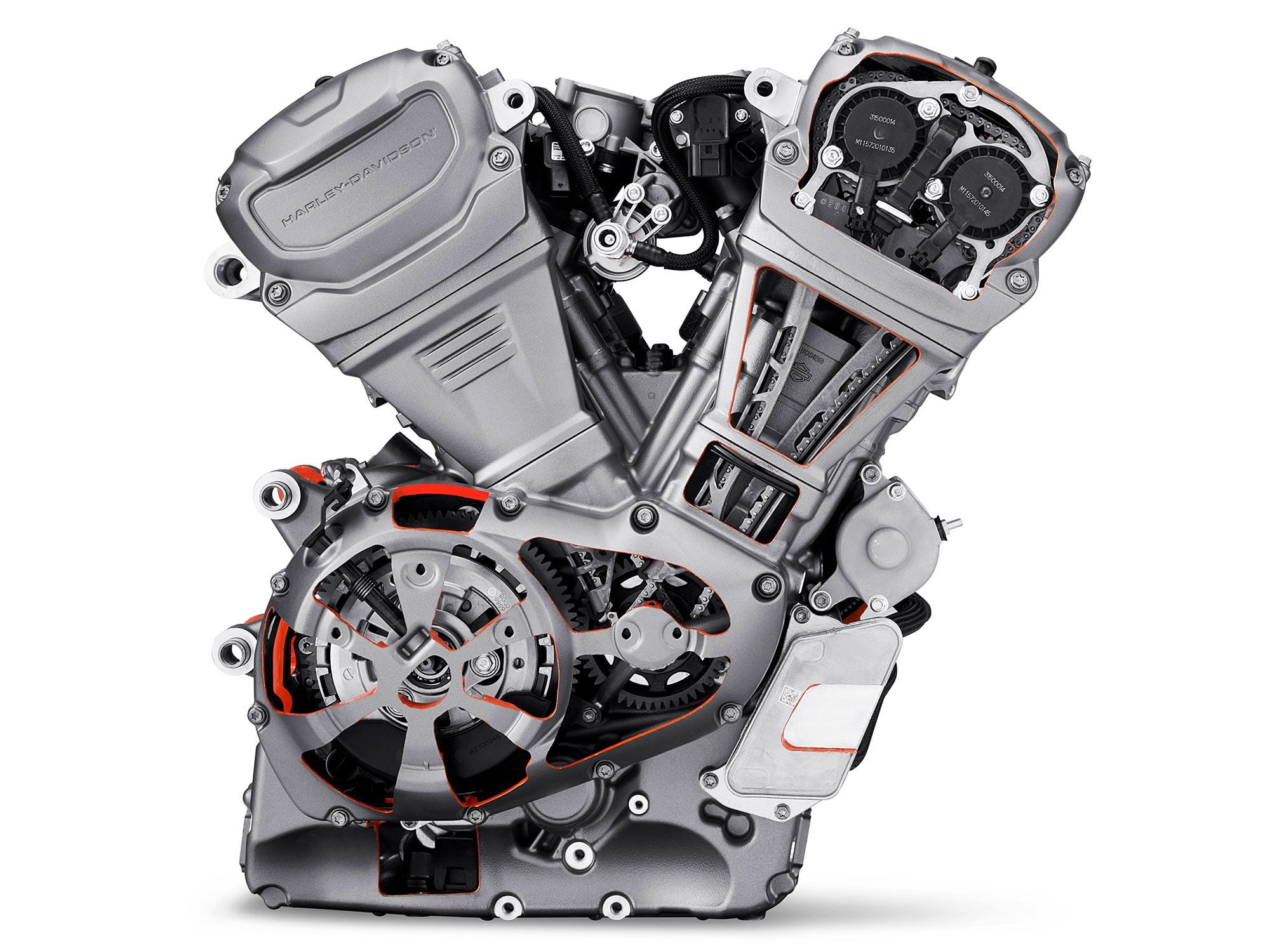
Both models ride on the same foundation, with the liquid-cooled Revolution Max 1250 as a stressed member of the chassis. (Harley-Davidson/) To reiterate, both the Pan America 1250 and Pan America 1250 Special are powered by the new liquid-cooled,150 hp Revolution Max 1250 engine, with the entire powertrain acting as a stressed member. The front frame, mid-frame, and tailsection bolt directly to the powertrain to reduce weight while stiffening up the chassis for better handling. Suspension travel is a healthy 7.5 inches at both ends—and adjustable. There are five ride modes, a host of electronic rider aids like cornering ABS and traction control and a configurable touchscreen display on both. So, other than the weight differential and different color options, what else distinguishes the base 1250 from the 1250 Special?
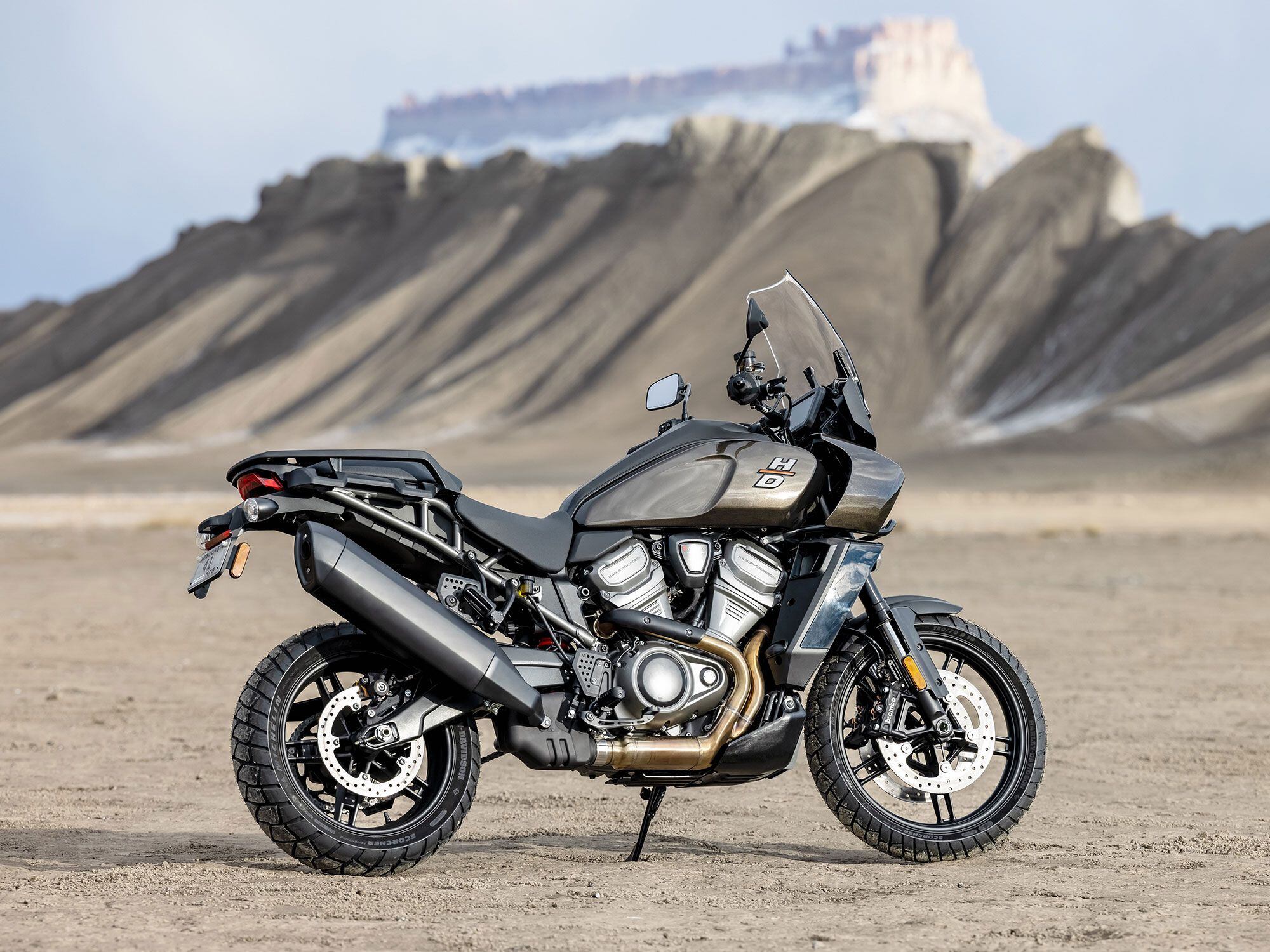
The Pan America 1250 base model comes equipped with adjustable suspension front and rear. (Harley-Davidson/) Pan America 1250
The Pan America 1250 base model comes out of the box with passive suspension that’s fully adjustable for preload and compression/rebound damping, featuring a Showa 47mm inverted cartridge fork up front and a Showa piggyback reservoir shock at the rear. Both bikes also feature an all-new braking system with radial Monoblock four-piston (30mm) caliper and dual 320mm front brake rotors and adjustable lever response from the front brake master cylinder.
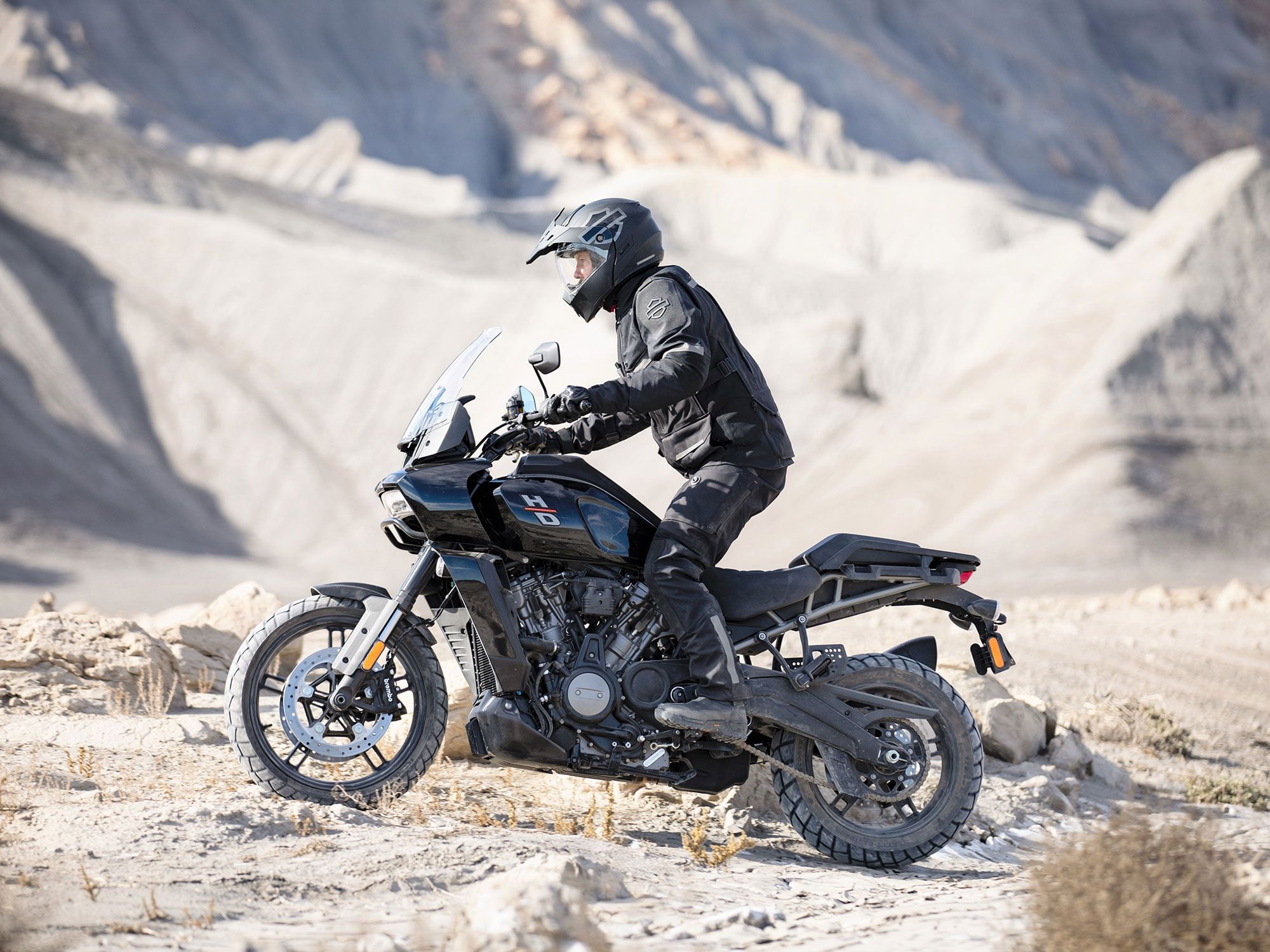
You get cornering ABS and traction control as well as five ride modes on both models. (Harley-Davidson/) The base 1250 model also offers Cornering Rider Safety Enhancements, a collection of electronic systems to optimize bike performance handling when the motorcycle is leaned over. On the Pan America 1250 model the systems include Cornering Enhanced Electronic Linked Braking (C-ELB), Cornering Enhanced Antilock Braking System (C-ABS), Cornering Enhanced Traction Control System (C-TCS), Cornering Enhanced Drag-Torque Slip Control System (C-DSCS), and Hill Hold Control.
Tying into those systems are five standard preprogrammed modes for riders to dial in, including Road, Sport, Rain, Off-Road, and Off-Road Plus. Each mode consists of a specific combination of power delivery, engine-braking, the C-ABS, and C-TCS settings made to pair performance to available traction during acceleration, deceleration, and braking. Both bikes also feature the Hill Hold Control (HHC) function, which is meant to prevent the bike from rolling when stopped, applying brake pressure until the rider actuates the throttle and clutch.
RELATED: Harley Reveals Hardwire Plan
Other standard features on both include cruise control, all-LED lighting, a four-way-adjustable windshield, toolless seat adjustability, and 6.8-inch tiltable TFT touchscreens.
But from there, the Special ladles on extra tech for better ride adjustability, offers more protection, and adds minor convenience features as well.
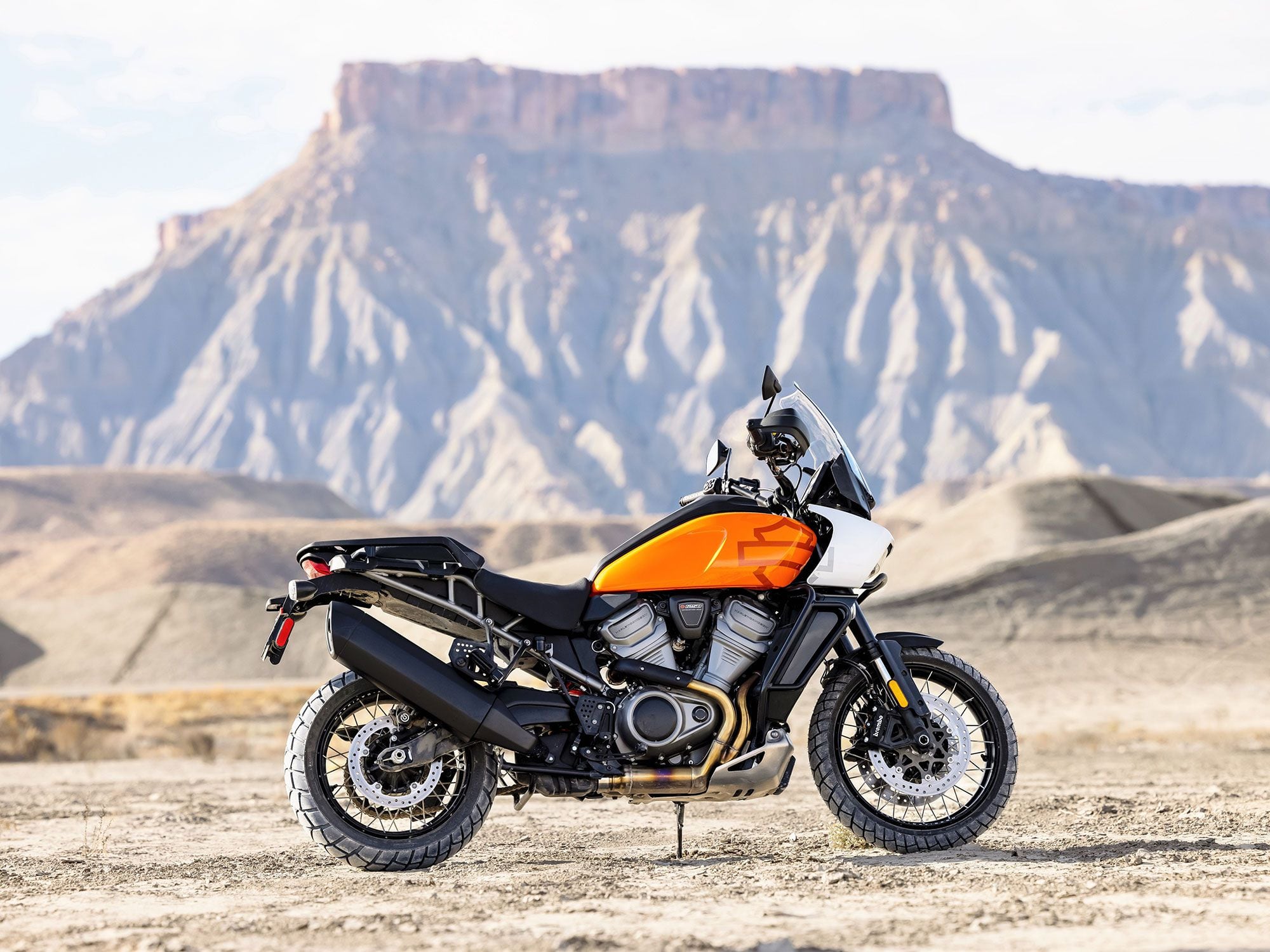
At the top of Harley’s first-ever ADV offering is the 1250 Special model, which adds another layer of tech and protection to the mix. (Harley-Davidson/) Pan America Special
First up is the added versatility of the 1250 Special’s suspension, which trumps the regular model with a semi-active system designed to react to suspension position, vehicle speed, roll angle, roll rate, applied throttle, and brake torque within the selected ride mode. That’s coupled with an additional Vehicle Loading Control system that senses the weight of the rider, a passenger and automatically adjusts rear preload for optimal sag (unladen seat height is 33.4 inches in the low position and 34.4 inches in the high position).
From within the semi-active suspension system, riders can choose from five preprogrammed profiles incorporated into each ride mode.
There’s Comfort, which gives more compliance and isolates the rider from rough road conditions; Balanced, which balances ride comfort with control for all-around riding; Sport, which serves up maximum control with higher damping rates for more heated romps; Off-Road Soft, which backs off of initial damping for better suspension compliance on larger hits; and Off-Road Firm, which increases initial damping for aggressive riding.
The actual components handling these scenarios are also well-matched, with a 47mm inverted Showa Balance Free Fork providing semi-active damping control on the front side, and a Showa coilover shock with electronic preload control and semi-active damping control out back. As with the 1250 base model, the rear suspension incorporates a linkage system connecting the shock, swingarm, and frame for a more progressive feel.
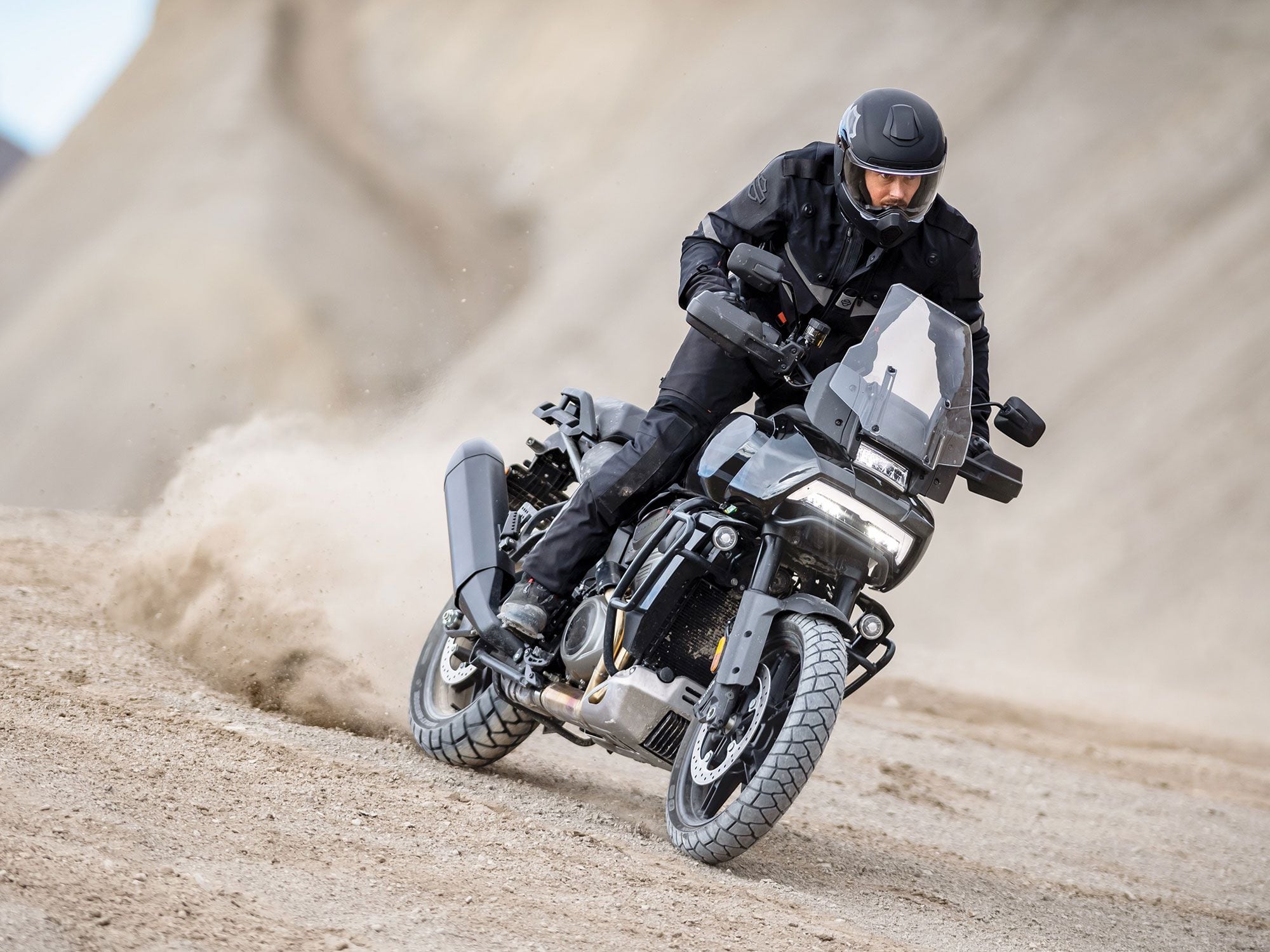
Shorties rejoice; Adaptive Ride Height (only available on the Special) could well be a game changer in the ADV market. (Harley-Davidson/) Adaptive Ride Height
If you’re looking for the latest bleeding-edge tech, the 1250 Special model can also be equipped with Adaptive Ride Height (ARH) as a $1,000 option—but on the Special only. The system, which H-D calls an industry first,” automatically transitions between a low stopped position and optimal ride height when the bike is moving.
With Adaptive Ride Height, the seat is lowered 1 to 2 inches when stopped (depending on automatically selected rear preload), but raised to optimize ground clearance and ride quality when the bike gets moving again, all while still retaining the benefits (and full wheel travel) of the semi-active suspension. Without a rider, seat height is 32.7 inches in Low and 33.7 inches in High.
Again, you have your modes here too. In Auto mode, suspension is lowered based on how forceful the braking, with the bike fully lowered by the time it comes to a stop; with Short Delay and Long Delay modes, the lowering waits until the motorcycle comes to a stop, with full ride height maintained otherwise; and in Locked mode, the ARH system stays at normal ride height all the way.
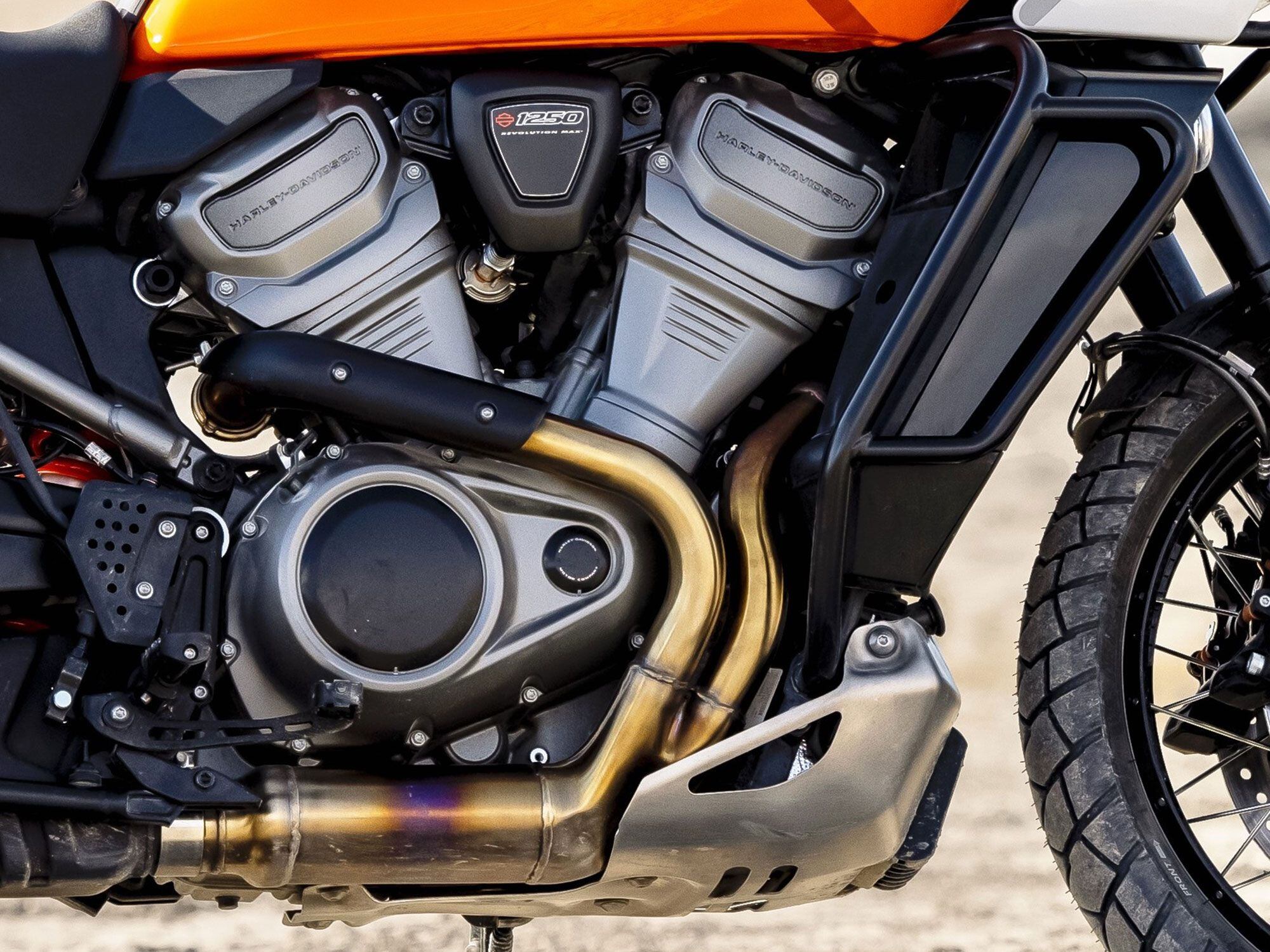
Standard protective elements on the Special include an aluminum skid plate and tubular steel bars bracketing the radiator. (Harley-Davidson/) Hold on; there are still more modes to talk about. Along with the five preprogrammed ride modes available on the base model, the Special adds two more that can be customized by the owner (as well as giving you additional adjustments within each; for example, Sport mode will also increase the rate of semi-active suspension damping at higher speeds on the Special). The two added settings on the Special are tailored to more experienced riders, who can choose from Off-Road Plus or Custom Off-Road Plus modes, for more aggressive stints in the dirty stuff. As for Hill Hold Control, in the US market only, the Pan America 1250 Special comes with a sidestand sensor interlock, so HHC to be engaged in neutral (which is not available on the Pan America 1250).
Tire Pressure Monitoring System (TPMS) also comes standard on the Special model,as do a centerstand, a rear brake pedal that’s height adjustable, and the expected vehicle protection accessories, such as steel brush guards for the radiator, aluminum skid plate to protect the engine crankcase, and hand deflectors. On the Special, heated handgrips are standard as well, while tubeless laced wheels are available as an option.
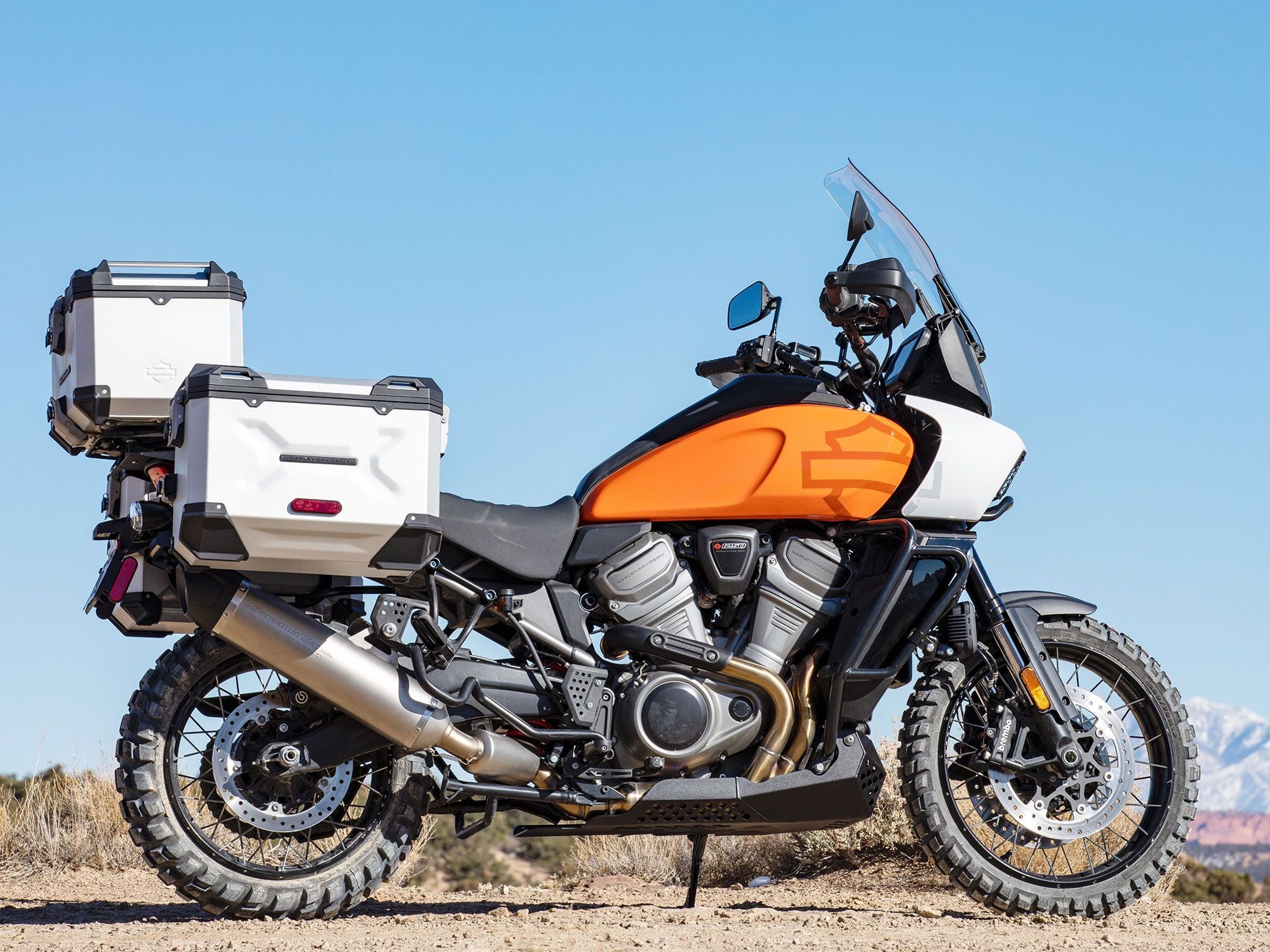
This being a Harley-Davidson product, you’ll be able to farkle out your new 1250 with all manner of available accessories, from aluminum cases to auxiliary lighting to accessory mufflers. (Harley-Davidson/) Finally, you can choose more hues on the Special, with options for Vivid Black; Gauntlet Gray Metallic; Deadwood Green (in select international markets only); two-tone Baja Orange and Stone Washed White Pearl. The Pan America 1250 and Pan America 1250 Special models will arrive at Harley-Davidson dealerships in the spring of 2021.
-
Hello Bridey,
Welcome to The Motorbike Forum. Please feel free to browse around and get to know the others. If you have any questions please don't hesitate to ask.
Why not tell us a bit about yourself too.
-
-
-

Triumph has upgraded the majority of its Bonneville family. You’re looking at seven models for 2021 so far. (Triumph Motorcycles/)When you’re updating a 60-year-old classic design for a new generation, you do so with kid gloves. A component upgrade here, a fresh coat of paint there, maybe a subtle logo update, and Bob’s your uncle. Even if that classic had a resurrection 20 years ago, you still don’t want to strip the familiarity right out of it. That was the challenge facing Triumph with its so-called Modern Classic line, which has long consisted of the best-selling Bonneville and its many variants; looming Euro 5 regulations demanded mechanical tweaks to meet emissions, and six years since the last overhaul, the series was also due for a face-lift—so Triumph did both. Enter the next generation of the Bonneville family, which in Triumph’s telling now holds seven models (though really it’s five if you take out submodels and limited editions), with the ever-recognizable Bonneville T120 still heading up the group of classic standards.

Less weight, more responsiveness, and better brakes mark the highlights for the T120. (Triumph Motorcycles/)Bonneville T120 and T120 Black
For 2021, the Bonneville range consists of the T120 (and T120 Black), their simpler T100 brother, the top-selling 900cc Street Twin offshoot, the ready-to-rumble Bonneville Bobber, and the more laid-back Bonneville Speedmaster. For the new year, they’ve all received some kind of update or improvement, many of them in the same area, and most of those incremental, whether in performance, ergonomics, refinement, or styling—or all of the above. There are no jaw-dropping reboots here, with the overall silhouettes maintaining the status quo, so when you see them on the road you’ll instantly know what you’re looking at.
The T120 flagship wheels into the new year with maybe the most subtle changes in the bunch. The classic form seems untouched and the spirited 1,200cc High-Torque parallel twin returns with performance numbers unchanged, yielding 78.9 hp and 77 pound-feet of torque on the Triumph spec sheet. But the Brits utilized a bit of weight reduction trickery within, giving the T120 a lighter crankshaft and tweaking the clutch and balancer shafts to reduce inertia, thus imbuing the engine with more responsive feel. Keeping that theme was the addition of lighter aluminum wheel rims, which Triumph says contributes to more agile steering; in all total weight reduction is a not insubstantial 15.5 pounds.
RELATED: New Triumph Street Scrambler Sandstorm Coming for 2022
The added responsiveness is tempered by a corresponding upgrade in the stopping department, thanks to higher-spec calipers and discs from Brembo. The T120′s new twin-piston sliding axial front calipers act on twin 310mm discs, paired with a single-piston floating caliper and 255mm disc out back. Braking performance is no doubt even further bolstered by the fact that the new bike weighs that much less too.

The twin discs are unchanged, but new Brembo calipers improve stopping performance. (Triumph Motorcycles/)Convenience matters, so Triumph added cruise control as a standard feature and enhanced the selectable standard rider modes, now allowing adjustment to the throttle map as well as traction control settings. More subtle changes onboard are the addition of new 3-D chromed tank badges, as well as a fresh instrument arrangement with 3-D dial faces and new display features (including access to turn off traction control). After that, details really get slight, with things like new machined fins on the engine and more chrome finishes and contrast piping on the seat.

The 2021 T120 Black gets the same subtle changes: less weight, less inertia, snappier engine. Cruise control is now standard. (Triumph Motorcycles/)With the T120 Black, it’s more of the same; take the base T120 and literally just paint it black, dabbing the wheel engine covers, mirrors, headlamp bucket, and exhaust in the dark stuff. Unless you’re talking about the unique dark brown seat, you’ll see pretty much the same upgrades here as on the standard T120, with the lighter wheels and beefier brakes below, and new instrument faces and badges up top.
Perhaps more impressive is that with just some minor juggling of cam profiles and exhaust revisions, Triumph was able to get the relatively unchanged 1,200cc engine to produce fewer emissions and meet Euro 5 requirements, with hydrocarbons to spare.
The new 2021 Bonneville T120 will be available in black, red/silver, and blue/silver (with hand-painted gold lining on the two-tone bikes) and the T120 Black can be had in black or black/gray (with silver lining on the latter). Both models are coming to North America starting May 2021 and will be priced at $12,050 USD.

With a combination of changing cam profiles and revised porting, Triumph was able to meet Euro 5 emissions requirements. (Triumph Motorcycles/)
The 2021 T100 still rolls with the 900cc HT engine, but it gains 10 hp. It also adds a new cartridge fork and upgraded brake calipers. (Triumph Motorcycles/)Bonneville T100
The T120 gets all the love, but really, the T100 is the one that channeled the 1959 icon first. Alas there’s no Black version this year (or a Bud Ekins edition, for that matter), but the 900cc classic still gets its share of performance tweaks and sleights of hand in the styling department. In fact, the 2021 T100 gets 10 more horses and is nearly 9 pounds lighter than its predecessor, in addition to receiving upgraded brakes and a new cartridge fork. Triumph lists the engine rating as 64 hp at 7,400 rpm, with higher power across the rev range, and a 500 rpm higher rev limit to boot. The torque peak of 59 pound-feet remains unchanged from the previous model, though on the new T100 the peak now arrives at a later 3,750 rpm. Again, Triumph credits a lighter-weight crankshaft, clutch and balance shafts as well as magnesium cam covers and revised ports and cam profiles for the boost in power and responsiveness. The engine is also now fully Euro 5 compliant, thanks partially to a secondary air system.
The T100 gets the same upgrade to its brake system as its higher-spec brother, with new Brembo calipers to improve bite, though it does retain the same wheel and tire sizes from last year. A new higher-spec 41mm cartridge fork also makes the scene, and the T100 seems a bit sleeker this time around, perhaps because it no longer wears rubber gaiters around the fork legs. Other elements of the bike have been blacked out as well, including the engine, cam, and sprocket covers—and we all know black is slimming. On the instrument side, there’s a new dial face, and ABS and switchable traction control come standard.
The 2021 Bonneville T100 will come to these North American shores starting March 2021, in a choice of black, red/white, and blue/white, any of which will lighten your wallet to the tune of $10,500.

Changes on the 2021 Street Twin include lower emissions, new cast wheels, and ribbed bench seat. (Triumph Motorcycles/)Street Twin
Triumph’s best seller in the Modern Classics line for the last few years running is back for 2021 and, short of a few minor styling and comfort boosts, heaves into view relatively unchanged. But then why would it be? The 900cc model has been a bona fide hit from Day One and after some fairly major updates in 2018, there isn’t much to fix this time around. Same 41mm cartridge fork, same 65 hp, 900cc high-torque engine, same Brembo brakes, same ABS and traction control. Of course it’s now Euro 5 compliant, but Triumph has seen fit to leave pretty much everything else alone, opting to embellish the Street Twin with new, stylish, 10-spoke cast wheels with machined details as perhaps the most noticeable change. A more shapely ribbed bench seat with thicker foam, new throttle body finishers, aluminum headlight brackets, and new tank decals round out the list of cosmetic touches, but otherwise the Street Twin keeps all of its goodness intact for 2021.
RELATED: How Much Power Does the 2020 Triumph Street Twin Make?
The new 2021 Street Twin will be available in black, blue, and Matt Ironstone (the latter with new stripe detailing) in North America starting in March 2021. The price remains pretty right as well, handily coming in under the $10K line at a suggested $9,400 USD.

The limited-edition Street Twin Gold Line Twin boasts a hand-painted black and gold color scheme. Only 1,000 are available. (Triumph Motorcycles/)Street Twin Gold Line
Joining the Bonneville series as a new model for 2021 is the Street Twin Gold Line, a limited-edition variant of the straight Street Twin that Triumph considers a stand-alone model. The hand-detailed custom special is pretty slick looking on the outside, featuring a classy matt black and gold paint scheme straight from Triumph’s expert color shop. The wheels are framed in thin elegant pinstripes, the tank logo is painted—even the knee pads are brushed. A hand-painted Gold Line edition-special side panel with custom logo decal IDs the bike for all to see, and only 1,000 editions of the bike will be produced worldwide, each coming with a certificate of authenticity.

Underneath the gold and black paint is a mostly stock Street Twin. (Triumph Motorcycles/)The Street Twin Gold Line also receives the same accents and styling tweaks as the standard 2021 Street Twin, which means the 10-spoke cast wheels with machined highlights (though these wear those fancy pinstripes), new ribbed bench seat, headlight brackets, and aluminum throttle body finishers, but underneath, it’s the same now-Euro 5-compliant base model. Which is not a bad thing, though we’d like to have seen a few more unique components to further distinguish the limited edition from its closely related stock brother. The Gold Line models will be here in June of 2021; price is yet to be announced.

There’s just one Bobber model in the Triumph range this year, combining the best bits of both of the 2020 models. So long, Bobber Black. (Triumph Motorcycles/)Bonneville Bobber
Triumph dabbles in another bit of consolidation for the Bobber series, with just one Bobber model representing the line for 2021. Triumph says the move was made easier for the fact that the 16-inch fat tire Black model was by far the better seller, giving us the model we see here for 2021, which merges the best qualities of both models. The upgraded and refined 2021 Triumph Bonneville Bobber carries over some of the black model’s darker elements naturally, but like most of the other new bikes here, it too gets better brakes and lighting upgrades, a more responsive 1,200cc high-torque engine (performance is unchanged though Triumph claims a flatter torque curve), and yep, it also meets Euro 5 requirements.

Fat 16-inch tires, a bigger fuel tank, and a higher-spec 47mm fork make the spec list this year. (Triumph Motorcycles/)But it’s not all emissions and styling; the Bobber adds a few more upgrades as well, like a larger 12-liter fuel tank (still only 3.2 gallons). Triumph also gives the new 2021 Bobber a higher-spec 47mm Showa fork, Brembo brake discs and calipers, and cruise control now added as standard feature, with all those components trickling down from the (previously) higher-spec Black model—along with that fat 16-inch front tire. Triumph added a few stylish tweaks in the form of black powdercoated engine cam and sprocket covers, and you also get an LED headlight with DRL, ABS, and switchable traction control as well as the slick adjustable solo seat to marry old-school cool with modern safety features.
The sole Bobber in the line will come in black, new Matt Storm Grey/Matt Ironstone, and red when it hits North America in March 2021, retailing for $13,150 USD.

The Speedmaster cruiser also refines engine response, adds a 47mm fork, and revamps the seat for more comfort. (Triumph Motorcycles/)Bonneville Speedmaster
The one true unashamedly cruiser-ish rig in the range is the laid-back, über-comfy Speedmaster, coming at you with fat tires, a plush two-up seat, and most of the other upgrades you’ve been reading about above, including a more responsive 1,200cc HT engine with lower inertia and lower emissions, that’s now also Euro 5 compliant.
Triumph says the engine’s peak power and torque numbers are unchanged (78 bhp peak power) but their curves are somewhat flatter, for more accessible power that lasts later in the rev range. To that, the Speedmaster also adds higher-spec 47mm Showa fork with 90mm of wheel travel for 2021, and a new more comfortable saddle with improved rider and pillion sections featuring thicker foam. You’ll also see a new dial face on the single instrument gauge which is likewise enclosed in a new bezel. Like the Bobber, the Speedmaster wears chunky 16-inch tires and comes with two ride modes, ABS and traction control, a full LED headlight, and cruise control as standard.

Full LED headlights, some with DRL, are featured on most of the new 2021 Bonneville range. (Triumph Motorcycles/)It’ll be available in black, as well as new colors including red and white/black. The Speedmaster will be in North America starting March 2021, with an MSRP of $13,150 USD.

Most of the 2021 model year bikes will be available by May or June at the latest. (Triumph Motorcycles/)
The 2021 Triumph Bonneville T120 from the rear. (Triumph Motorcycles/)If you’re wondering about the Thruxton line, well the new RS launched last year, and the official reveal of the new-generation Scrambler 1200 models as well as the Street Scrambler will come in April 2021. No word as yet on if the Speed Twin will get any redos for 2021, but we’ll let you know as soon as we do.
-
-
Hello Chris,
Welcome to The Motorbike Forum. Please feel free to browse around and get to know the others. If you have any questions please don't hesitate to ask.
Why not tell us a bit about yourself too.
-

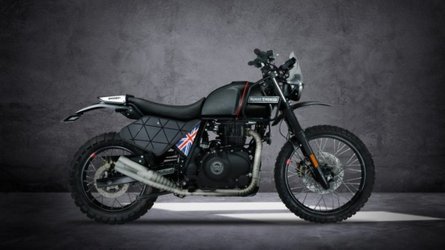
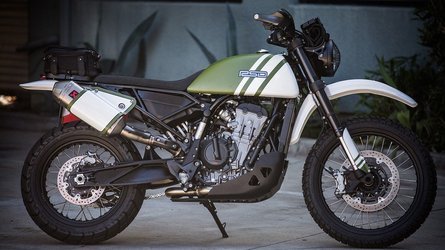
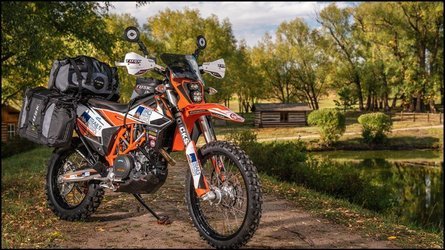
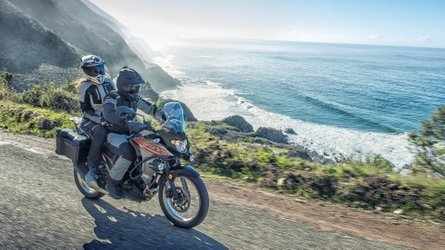

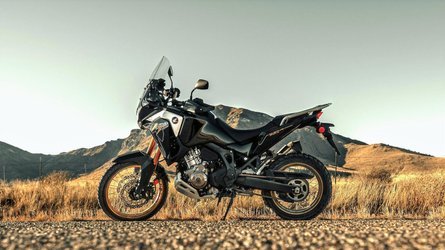
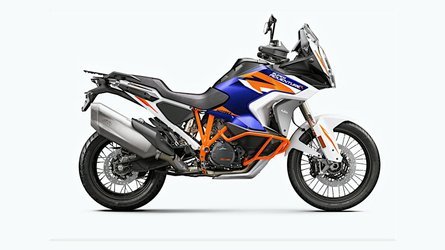
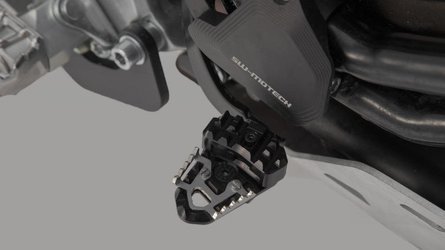
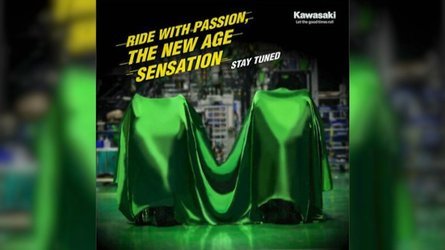
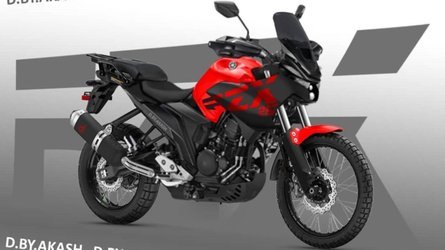
Welcome Isma
in Newbies
Posted
Hello Isma,
Welcome to The Motorbike Forum. Please feel free to browse around and get to know the others. If you have any questions please don't hesitate to ask.
Why not tell us a bit about yourself too.